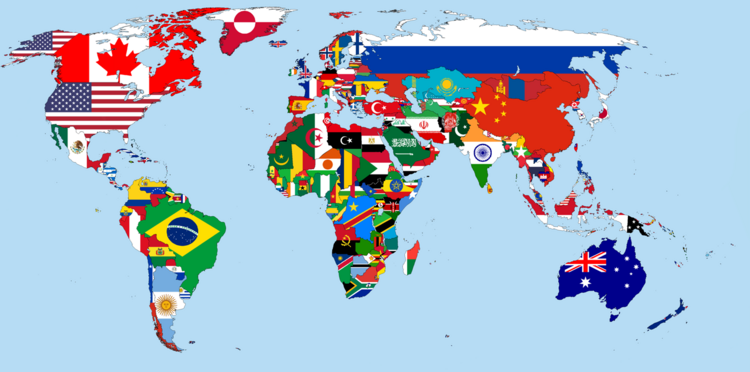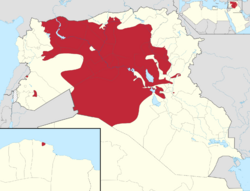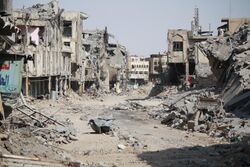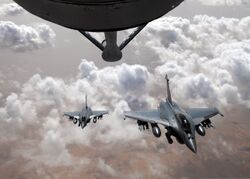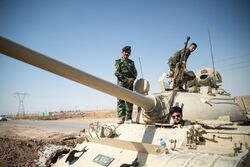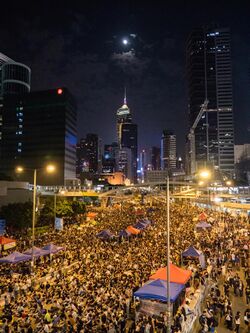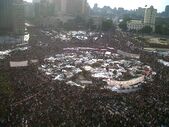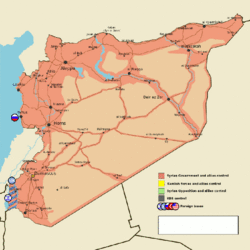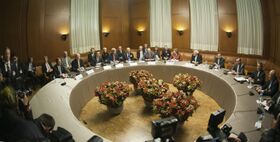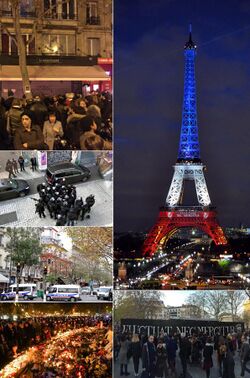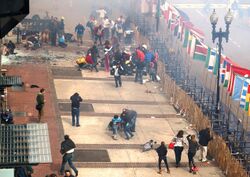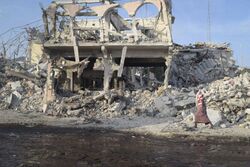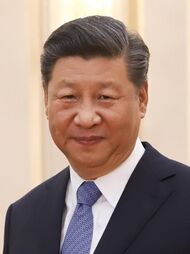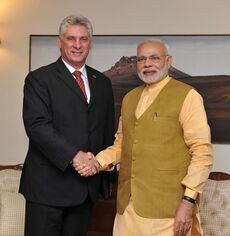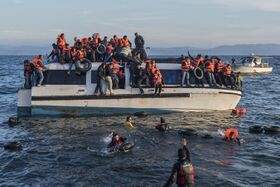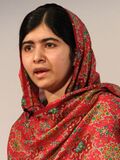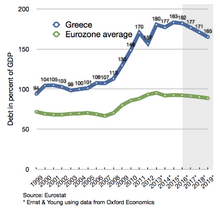History:2010s
Error: No valid link was found at the end of line 3.
The 2010s (pronounced ''"twenty-tens" or "two thousand (and) tens"), variously nicknamed "the '10s" ("the Tens"), "the Tenties", or more rarely "the Teens") was a decade that began on January 1, 2010, and ended on December 31, 2019.
The decade began with an economic recovery from the late 2000s financial crisis. Inflation and interest rates stayed low and steady throughout the decade, gross world product grew from 2010 to 2019. Global economic recovery accelerated during the latter half of the decade, fueled by strong economic growth in many countries, robust consumer spending, increased investment in infrastructure, and the emergence of new technologies. However, the recovery developed unevenly. Socioeconomic crises in some countries—particularly in the Arab world—triggered political revolutions in Tunisia, Egypt, and Bahrain as well as civil wars in Libya, Syria, and Yemen in a regional phenomenon that was commonly referred to as the Arab Spring. Meanwhile Europe had to grapple with a debt crises that was pronounced early in the decade. Shifting social attitudes saw LGBT rights make substantial progress throughout the decade, particularly in developed countries.
The decade saw the musical and cultural dominance of dance-pop, electronic dance music, hipster culture and electropop. Globalization and an increased demand for variety and personalisation in the face of music streaming services such as Spotify, SoundCloud and Apple Music created many musical subgenres. As the decade progressed, diversity was also seen with the mainstream success of K-pop, Latin music and trap. Superhero films became box office leaders, with Avengers: Endgame becoming the highest-grossing film of all time.[note 1] Cable providers saw a decline in subscribers as cord cutters switched to lower cost online streaming services such as Netflix, Amazon Prime, Hulu and Disney+. The video game industry continued to be dominated by Nintendo, Sony, and Microsoft; while indie games became more popular, with Minecraft becoming the best-selling game of all time. Handheld console gaming revenue was overtaken by mobile gaming revenue in 2011. The best-selling book of this decade was Fifty Shades of Grey. Drake was named the top music artist of the decade in the US by Billboard.[note 2]
The United States continued to retain its superpower status while China sought to expand its influence in the South China Sea and in Africa through its economic initiatives and military reforms. It solidified its position as an emerging superpower, despite causing a series of conflicts around its frontiers. Within its border, China enhanced its suppression and control of Hong Kong, Xinjiang, and Tibet. These developments led the United States to implement a containment policy and initiate a trade war against China. Elsewhere in Asia, the Koreas improved their relations after a prolonged crisis between the two countries, and the War on Terror continued as a part of the U.S.'s continued military involvement in many parts of the world. The rise of the Islamic State of Iraq and the Levant extremist organization in 2014 erased the Syria-Iraq border, resulting in a multinational intervention against it. In Africa, South Sudan broke away from Sudan, and mass protests and various coups d'état saw longtime strongmen deposed. In the U.S., celebrity businessman Donald Trump was elected president amid an international wave of populism and neo-nationalism. The European Union experienced a migrant crisis in the middle of the decade and withdrawal of the United Kingdom as a member state following the historic United Kingdom EU membership referendum. Russia attempted to assert itself in international affairs, annexing Crimea in 2014.
Information technology progressed, with smartphones becoming widespread. Internet coverage grew from 29% to 54% of the world population, and also saw advancements in wireless networking devices, mobile telephony, and cloud computing. Advancements in data processing and the rollout of 4G broadband allowed data, metadata, and information to be collected and dispersed among domains at paces never before seen while online resources such as social media facilitated phenomena such as the Me Too movement, the rise of slacktivism, and online cancel culture. WikiLeaks gained international attention for publishing classified information on topics related to Guantánamo Bay, Syria, the Afghan and Iraq wars, and United States diplomacy. Edward Snowden blew the whistle on global surveillance, raising awareness on the role governments and private entities play in global surveillance and information privacy. Baidu (4th), Twitter (6th) and Instagram (8th) emerged to become among the top 10 most visited websites, while Wikipedia went from the 9th to the 5th most popular website, almost sextupling its monthly visits. Yahoo significantly declined in popularity, descending from being the 1st to the 9th most popular site, with monthly visits declining by two-thirds. Google, Facebook, YouTube and Yandex maintained relatively consistent popularity and remained within the top 10 throughout the decade.
Global warming became increasingly noticeable through new record temperatures in different occurrences and extreme weather events on all continents. The CO2 concentration rose from 390 to 410 PPM over the decade. At the same time, combating pollution and climate change continued to be areas of major concern, as protests, initiatives, and legislation garnered substantial media attention. The Paris Agreement was adopted in 2015, and the global climate youth movement was formed. Major natural disasters included the 2010 Haiti earthquake, the 2011 Tōhoku earthquake and tsunami, the Nepal earthquake of 2015, the 2018 Sulawesi earthquake and tsunami, the devastating hurricanes Bopha (Pablo), Haiyan (Yolanda), and Maria, as well as the 2019 European heat waves.
During the decade, the world population grew from 6.9 to 7.7 billion people. There were approximately 1.4 billion births during the decade (140 million per year), and about 560 million deaths (56 million per year).[3]
Nicknames
The decade has been variously termed "the '10s" ("The Tens"), occasionally "The Teens",[citation needed] and (especially in the UK) "the Tenties".[4][5][6]
Politics and wars
Major conflicts
The prominent wars of the decade include:
International wars
| Name | Start date | End date | Description |
|---|---|---|---|
Israeli–Palestinian conflict
|
14 May 1948
|
Ongoing
|
Conflict between Jewish and Arab communities in Israel and the West Bank have been ongoing since 1948.[7] After Israel occupied the West Bank, it began making settlements there, which has been an obstacle to the peace process.[8] Tensions also remained high as Hamas, which controls the Gaza Strip, has been launching rockets and cross-border raids into Israeli territory, which Israel has responded with force.[9] |
Nagorno-Karabakh conflict
|
February 1988
|
Ongoing
|
The region of Karabakh has been disputed over the Republic of Artsakh, which is supported by the Armenian government. A ceasefire was held in 1994. From April 1–5, 2016, clashes began along the Nagorno-Karabakh line of contact with the Artsakh Defence Army, backed by the Armenian Armed Forces on one side and the Azerbaijani Armed Forces on the other. A ceasefire was reached on 5 April between Azerbaijan and Armenia in Moscow. From May 20–27, 2018, clashes in former no man's land[10] in the Nakhchivan Autonomous Republic, an exclave of Azerbaijan, led to Azerbaijan reoccupying Günnüt and several other strategic villages and positions.[11][12] |
War on terror
|
11 September 2001
|
Ongoing
| |
| 2011 military intervention in Libya | 19 March 2011 | 31 October 2011 | Following United Nations Security Council Resolution 1973, a NATO-led coalition launched an air campaign backing anti-Gaddafi rebels against Muammar Gaddafi's government in the Libyan Civil War. |
Russo-Ukrainian War
|
20 February 2014
|
Ongoing
|
After the fall of Ukrainian president Viktor Yanukovych, Russian soldiers took control of strategic positions in the Ukrainian territory of Crimea and subsequently annexed the region after a controversial referendum.[13] In the months that followed, demonstrations in Donbas escalated into an armed conflict between the government of Ukraine and Russian-backed separatist forces. On 24 February 2022, it concluded with the Russian invasion of Ukraine |
| War against the Islamic State | 13 June 2014 | Ongoing | In late 2013, a terrorist organisation called the Islamic State of Iraq and the Levant began making rapid advances and territorial gains in Iraq and Syria. It captured Mosul in June[14] and made Raqqa its capital.[15] Various international coalitions led by the United States, France, Russia, and Muslim states and with aid from dozens of countries were formed to help fight the militants.[16][17] By December 2017, ISIL had lost all of its territory in Iraq and 95% of its territory in Syria,[18] and was militarily and territorially defeated on 23 March 2019.[19] |
| Saudi-led intervention in the Yemeni civil war | 26 March 2015 | During the Yemeni Civil War, Saudi Arabia, United Arab Emirates, and other countries invaded parts of Yemen in order to depose the Houthi-controlled government. | |
Turkish involvement in the Syrian Civil War
|
5 December 2011
|
Ongoing
|
During the Syrian Civil War, Turkey invaded parts of northern Syria in order to combat the Islamic State of Iraq and the Levant and the Syrian Democratic Forces, fostering and funding the Syrian National Army of the Syrian Interim Government, culminating in its 2019 offensive into northeastern Syria in which over 300,000 civilians were displaced[20] and dozens more killed,[21][22][23] prompting a controversial reaction worldwide in response to reported human rights violations[24][25][26] and resettlement of Kurds which has been viewed as possible ethnic cleansing.[27][28][29] |
| 2019 India–Pakistan border skirmishes | 14 February 2019 | 22 March 2019 | After a suicide car bombing on 14 February 2019 where 40 Indian security personnel are killed,[30] the Indian Air Force launches airstrikes on purported terrorist camps in Muzaffarabad and Chakothi areas of Pakistan-administered Kashmir, and Balakot in mainland Pakistan , leading to said standoff.[31] Also involved was Jaish-e-Mohammed, a Pakistani militant group that took responsibility for the bombing and the purported target of Indian attacks. |
Civil wars
| Name | Start date | End date | Description |
|---|---|---|---|
| Colombian Armed Conflict | 27 May 1964 | Ongoing | Low-intensity and asymmetrical between the Colombian government, left-wing guerrillas, and various paramilitary factions had been ongoing since 1964. However, at the start of the decade, only two major groups remained, FARC and ELN.[32] Since 2012, both groups have been in peace talks with the government, with FARC and the government signing a historic ceasefire signed 23 June 2016.[33] Though the peace deal was initially rejected by voters in October,[34] a revised deal was successfully and unanimously passed by the Congress on 30 November 2016, bringing an end to much of the fighting that had been going on for almost 50 years.[35][36] |
| Insurgency in Khyber Pakhtunkhwa | 16 March 2004 | Since 2004, Pakistan has been fighting an insurgency by various armed militant groups aligned with the Taliban or ISIL in Khyber Pakhtunkhwa along its border with Afghanistan.[37] The violence has killed at least 61,549 people since[38] and over 6 million displaced,[39] gutting the nation's economy and resources.[40][41] By 2014, however, casualties from terrorist and militant attacks had dropped by around 40%,[42] in spite of rampant massacres such as the 2014 Peshawar school massacre, which led to 156 deaths.[43] | |
| Insurgency in Paraguay | 27 August 2005 | Since 2005, Paraguay has been fighting a low-level insurgency by various Marxist–Leninist[44] armed militant groups in the country, including the Paraguayan People's Army, the Armed Peasant Association, and the Army of Marshal López. Between 2005 and 2014, at least 50 have died alongside 28 kidnappings and 85 "violent acts,"[45] concentrated in the highly populated northeastern departments of Amambay, Caaguazú, Canindeyú, Concepción, and San Pedro. Exact numbers vary, but the conflict is estimated to have caused a cumulative 111 deaths by 2020, most of which have been insurgents, local ranchers, and police officers.[45] | |
| Mexican drug war | 11 December 2006 | Following a rise in criminal violence as a result of increasingly influential drug trafficking in the country, Mexican President Felipe Calderón declared a war on drugs on 11 December 2006.[46] Since the start of the war, the death toll from drug violence has sharply increased,[47] with a death toll of nearly 300,000[48] over 60,000 missing, and 39,000 unidentified bodies in morgues.[49] Arrests of key cartel leaders led to increasing violence as cartels, who dominate the billion-dollar illegal drug industry,[50][51] fought for control of trafficking routes into the United States.[52][53][54] The conflict has also emphasised corruption and human rights abuses, with bribery, drug smuggling, kidnapping, and protection of drug cartels being widely reported among government officials.[50][55] | |
| Somali Civil War | 31 January 2009 | In 2009, Al-Shabaab, an Islamist militant group, began waging an insurgency against the newly formed Transitional Federal Government. In 2011, the federal government captured Mogadishu[56] and subsequently retook several towns across the country.[57] Since then, the government has attempted to clean out the remaining Al-Shabaab strongholds with help from AMISOM soldiers[58] and military intervention on the part of the United States . Al-Shabaab made a resurgence in 2016, when AMISOM and Kenyan forces were subject to multiple attacks and raids,[59] to which American and Somali forces responded with increasingly intense airstrikes,[60][61] weakening Al Shabaab's territorial prominence in the years following. The conflict has cost anywhere from 300,000 to 500,000 lives and has devastated Somalia's infrastructure and humanitarian resources.[62][63] | |
| Boko Haram insurgency | 26 July 2009 | Sparked by long-standing conflict between Nigeria's Christian and Muslim communities, Boko Haram insurgency began when the jihadist rebel group started an armed rebellion against the government of Nigeria.[64] In 2015, the group pledged alliance to ISIL,[65] becoming the world's deadliest terrorist group by 2015.[66][67] The conflict has killed over 37,500 people and displaced another 2.5 million, driving 244,000 Nigerian refugees into neighbouring states.[68] Insurgents were severely weakened in 2015 when Nigerian forces drove them into Sambisa Forest,[69] causing bitter infighting.[70] However, they made a resurgence in 2018 and 2019, with human rights violations; massacres; and mass child kidnappings, exploitation, and torture continuously posing a threat to civilians.[71][72][73][74] | |
| Mali War | 16 January 2012 | In January 2012, a rebellion by Tuaregs in Northern Mali began. After Malian president Amadou Toumani Touré was ousted in a coup d'état, Tuaregs captured Northern Mali,[75] and declared it to be the independent state of Azawad.[76] However, shortly afterward, various Islamists groups took over Northern Mali from the Tuaregs and imposed sharia law on the region.[77] | |
| South Sudanese Civil War | 15 December 2013 | 22 February 2020 | A multi-sided civil war between government forces and opposition forces including SPLM-IO and other groups. Ugandan troops were deployed to fight alongside the South Sudanese government.[78] The United Nations deployed peacekeepers as part of the United Nations Mission in South Sudan.[79] |
| War in Iraq | 1 January 2014 | 9 December 2017 | The civil war began with the conquest of Fallujah, Mosul, Tikrit and major areas of northern Iraq by the Islamic State of Iraq and the Levant. Various nations provided aid in the form of airstrikes, troops and intelligence.[80][81] On 9 December 2017, Prime Minister Haider al-Abadi announced victory over ISIL,[82] though others warned to expect ISIL to continue the fight by other means.[83] |
| Libyan civil war | 16 May 2014 | 24 October 2020 | Following the factional violence that engulfed Libya after the fall of Muammar Gaddafi, a second civil war broke out among rival factions seeking control of the territory and oil of Libya. The conflict at the beginning was mostly between the House of Representatives (HoR) government that was controversially elected in 2014, also known as the "Tobruk government"; and the rival General National Congress (GNC) government, also called the "National Salvation Government", based in the capital Tripoli, established after Operation Odyssey Dawn and the failed military coup. A permanent ceasefire agreement in all areas of Libya became effective from 24 October 2020, ending the war.[84][85] |
| Yemeni Civil War | 16 September 2014 | Ongoing | Preceded by a decade-long Houthi insurgency,[86] the Yemeni Civil War began between two factions: the then-incumbent Yemeni government, led by Abdrabbuh Mansur Hadi, and the Houthi militia, along with their supporters and allies. Both claim to constitute the Yemeni government.[87] |
| Philippine drug war | 30 June 2016 | Following a rise in criminal violence as a result of drug trafficking in the country, since Philippine President Rodrigo Duterte was inaugurated on 30 June 2016.[88] As of 2020, it has caused about 6000 deaths.[89] | |
| Siege of Marawi | 23 May 2017 | 23 October 2017 | The battle of Marawi was a five-month-long armed conflict in Marawi, Philippines , that started on May 23, 2017, between Philippine government security forces against militants affiliated with the Islamic State (IS), including the Maute and Abu Sayyaf Salafi jihadist groups. The battle also became the longest urban battle in the modern history of the Philippines. |
| Anglophone Crisis | 9 September 2017 | Ongoing | Following the suppression of 2016–17 protests by Cameroonian authorities, Ambazonian separatists in the Anglophone regions (formerly collectively known as the Southern Cameroons) launched a guerrilla campaign against the Cameroon Armed Forces, and later unilaterally proclaimed independence. In November 2017, the government of Cameroon declared war on the separatists and sent its army into the Anglophone regions. |
| Insurgency in Cabo Delgado | 5 October 2017 | The insurgency in Cabo Delgado is an ongoing Islamist insurgency in Cabo Delgado Province, Mozambique, mainly fought between militant Islamists and jihadists attempting to establish an Islamic state in the region, and Mozambican security forces. Civilians have been the main targets of terrorist attacks by Islamist militants. The main insurgent faction is Ansar al-Sunna, a native extremist faction with tenuous international connections to ISIS. | |
| Islamic State insurgency in Iraq | 9 December 2017 | The insurgency in Iraq is an ongoing low-intensity insurgency that began in 2017 after ISIS lost its territorial control in the War in Iraq, during which ISIS and allied White Flags fought the Iraqi military (largely backed by the United States , United Kingdom and other countries conducting airstrikes against ISIS) and allied paramilitary forces (largely backed by Iran). | |
| Catatumbo campaign | January 2018 | The Catatumbo campaign has been an ongoing period of strategic violence between militia faction groups in the Catatumbo region (es) of Colombia and Venezuela since January 2018. It is an extension of the War on drugs and developed after the Colombian peace process of 2016. |
Revolutions and major protests
Successful revolutions and otherwise major protests of the decade include, but are not limited to:
| Event | Date | Country | Events | Ref. |
|---|---|---|---|---|
| 2010 Kyrgyz Revolution | 6 April – 14 December 2010 | Kyrgyz President Kurmanbek Bakiyev fled Bishkek amid fierce anti-government riots as the opposition seized control. | [90] | |
| Occupy Wall Street and the Occupy movement | 17 September 2011 – c. 2013 | Hundreds of protesters marched into the financial district of Wall Street in New York City , beginning the Occupy Wall Street movement. | [91] | |
| Rojava revolution | 19 July 2012 – present | Template:Country data Rojava | A sub-conflict of the Syrian Civil War. | |
| Gezi Park protests | 28 May 2013 – 30 August 2013 | A wave of demonstrations and civil unrest in Turkey began on 28 May 2013, initially to contest the urban development plan for Istanbul's Taksim Gezi Park. | ||
| Euromaidan and the Revolution of Dignity | 21 November 2013 – 23 February 2014 | Ukrainian President Viktor Yanukovych fled the country following violent protests in the capital, Kyiv. The opposition-controlled Verkhovna Rada voted to remove Yanukovych as president. | [92] | |
| Abkhazian Revolution | 27 May – 1 June 2014 | In a quick turn of events, the president of the breakway republic, Alexander Ankvab, was ousted from power after the government building was stormed.[93] | ||
| 2014 Burkina Faso uprising | 28 October – 3 November 2014 | A series of demonstrations and riots in Burkina Faso in October 2014. Demonstrations began in response to controversial attempts to introduce a constitutional amendment that would lift term limits and allow President Blaise Compaoré to run for additional terms as president and extend his years in office. On October 30, Compaoré dissolved the government and fled to Côte d'Ivoire and was succeeded by Yacouba Isaac Zida. | ||
| 2015–2016 protests in Brazil | 15 March 2015 – 31 July 2016 | In 2015 and 2016, a series of protests in Brazil denounced government corruption and the presidency of Dilma Rousseff, being the largest popular mobilisations in the country since the beginning of the "New Republic". | [94] | |
| Burundian unrest | 26 April 2015 – 17 May 2018 | Burundi faces unrest as President Pierre Nkurunziza seeks a third term in office, resulting in hundreds killed and thousands more fleeing the country. | [95] | |
| 2018–2019 Gaza border protests | 30 March 2018 – 27 December 2019 | Protests against the Blockade of the Gaza Strip, with 183 protesters killed.[96] | ||
| 2018 Armenian Revolution | 31 March – 8 May 2018 | Various political and civil groups led by member of parliament Nikol Pashinyan staged anti-government protests in Armenia. Prime Minister Serzh Sargsyan resigned on 23 April 2018. Nikol Pashinyan was elected Prime Minister on 8 May 2018. | [97][98] | |
| 2018 Bangladesh road-safety protests | 29 July – 1 September 2018 | Nation-wide protests mainly by students after reckless driving caused deaths of two high school students. | [99][100] | |
| Yellow vests protests | 17 November 2018 – present | France experiences its worst civil unrest since the protests of 1968 due to the yellow vests movement. Protests in Paris morph into riots, with hundreds of people injured and thousands arrested. Over 100 cars are burned and numerous tourist sites are closed. | [101] | |
| Sudanese revolution | 19 December 2018 – 12 September 2019 | Amid mass protests, Omar al-Bashir is deposed as President of Sudan in a coup d'état, after nearly 30 years in office. | [102] | |
| 2019–2020 Hong Kong protests | 9 June 2019 – 2020 | Mass protests take place in Hong Kong against an extradition bill that many observed would subject Hong Kong residents and those passing through the city to de facto jurisdiction of Chinese courts. Despite Hong Kong Chief Executive Carrie Lam announcing the bill to be "dead" after weeks of mass protests, waves of localised demonstrations continued, some resulting in violent clashes between police, pro-democracy activists, local residents, and Triad members. | [103][104] | |
| 2019 Ecuadorian protests | 3 – 14 October 2019 | On 3 October 2019, taxi, bus and truck drivers came out in protest against the planned fuel subsidy abolition and austerity measures announced by President Lenín Moreno. The government seat was relocated from Quito to Guayaquil and a state of emergency was declared following violent protests. | [105] | |
| 2019–2022 Chilean protests | 7 October 2019 – 21 December 2021 | On 18 October 2019, a period of mass protests and violent unrest began in Chile. The protests were initially in response to a fare hike on the Santiago Metro, but the scope of the protestors' demands has since expanded. | [106] | |
| 2019 Bolivian protests | 21 October – 21 November 2019 | Following a disputed election, protests forced Evo Morales, the president since 2006, to resign and flee to Mexico.[107] The new president, Jeanine Áñez, continued to face opposition from pro-Morales protestors.[108] |
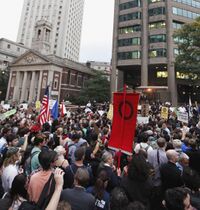 Concerns over social and economic inequality, greed, corruption and the influence of corporations on government led to the rise of the Occupy Wall Street movement in 2011 |
Arab Spring
The Arab Spring was a series of anti-government protests, uprisings, and armed rebellions that spread across much of the Islamic world in the early 2010s. It began in response to oppressive regimes and a low standard of living, starting with protests in Tunisia.[109][110] In the news, social media has been heralded as the driving force behind the swift spread of revolution throughout the world, as new protests appear in response to success stories shared from those taking place in other countries. In many countries, the governments have also recognised the importance of social media for organising and have shut down certain sites or blocked Internet service entirely, especially in the times preceding a major rally.[111] Governments have also scrutinised or suppressed discussion in those forums through accusing content creators of unrelated crimes or shutting down communication on specific sites or groups, such as through Facebook.[112]
| Event | Date | Country | Description | Ref. |
|---|---|---|---|---|
| Tunisian Revolution | 18 December 2010 – 14 January 2011 | Amidst anti-government protests, Tunisia's president Zine El Abidine Ben Ali dissolved the government, declared a state of emergency and resigned from office. | [113] | |
| 2011 Egyptian revolution | 25 January – 11 February 2011 | On 11 February 2011, Vice President Omar Suleiman announced that Mubarak resigned as president, turning power over to the Supreme Council of the Armed Forces (SCAF). | ||
| 2011 Bahraini uprising | 14 February – 18 March 2011 | Hamad bin Isa Al Khalifa, King of Bahrain, declared a three-month state of emergency as troops from the Gulf Co-operation Council were sent to quell the civil unrest. | [114] | |
| Libyan civil war | 15 February – 13 October 2011 | Facing protests against his 42-year rule, Muammar Gaddafi refused to step down and sent in the military to brutally quell protests.[115][116] As a result, many army units defected to the opposition and protests soon turned into an armed rebellion.[117] With international help, the rebels captured Tripoli,[118] and eventually Sirte, Gaddafi's hometown and last outpost, where he was killed.[119] | ||
| Syrian civil war | 15 March 2011 – present | Protests erupted in Syria against President Bashar al-Assad's rule, with police and the army sent in to crack down on protesters.[120][121] They later morphed into war after army officers defected to the opposition, forming the Free Syrian Army (FSA).[122] It led to the Kurdish parties called the SDF to secede from Northeastern Syria, forming Rojava. The war also allowed for Islamic extremist groups like Al-Nusra Front and ISIL to temporarily take control of vast amounts of territory. |
Nuclear proliferation
- On 8 April 2010, the United States and Russia signed a treaty in Prague, Czech Republic agreed to reduce the stockpiles of their nuclear weapons by half. It is meant to replace the Strategic Offensive Reductions Treaty (SORT), which was set to expire.[123] The treaty went into force on 5 February 2011 after it was ratified by both nations.[124]
- In 2015, Iran and other world powers agreed to trade sanctions relief for explicit constraints on Iran's contentious nuclear program, including allowing the inspections of nuclear facilities by the International Atomic Energy Agency (IAEA).[125] On 16 January 2016 the IAEA confirmed that Iran had complied with the agreement (the JCPOA), allowing the United Nations to lift sanctions immediately.[126][127] However, on 8 May 2018, United States President Donald Trump announced the United States was withdrawing from the deal.[128]
- On 7 July 2017, the United Nations passed the Treaty on the Prohibition of Nuclear Weapons, the first legally binding international agreement to comprehensively prohibit nuclear weapons, with the goal of leading towards their total elimination.[129][130] It has been signed by 58 nations.[131]
- Throughout the decade, North Korea expanded its nuclear capabilities, performing alleged nuclear tests in 2013[132] and 2016,[133] which governments responded by placing international sanctions on the country.[134][135] In response North Korea has threatened the United States, South Korea and Japan with pre-emptive nuclear strikes.[136] However, in 2018, North Korea suggested that they may disarm their nuclear arsenal after negotiations with the United States.
- On 1 February 2019, The US formally suspended the Russo-American Intermediate-Range Nuclear Forces Treaty (INF),[137] and Russia did the same on the following day in response. The US formally withdrew from the treaty on 2 August 2019.[138]
- The United States initiated a renovation of its nuclear weapon arsenal.
Terrorist attacks
The most prominent terrorist attacks committed against civilian populations during the decade include, but are not limited to:
| Event | Date | Country | Deaths | Injuries | Ref. |
|---|---|---|---|---|---|
| 2010 Lakki Marwat suicide bombing | 1 January 2010 | Pakistan | 105 | 100+ | [139] |
| 2010 Moscow Metro bombings | 29 March 2010 | Russia | 40 | 102 | [140] |
| 2011 Mumbai bombings | 13 July 2011 | India | 26 | 130+ | [141] |
| 2011 Norway attacks | 22 July 2011 | Norway | 77 | 319+ | [142] |
| 2011 Mogadishu bombing | 4 October 2011 | Somalia | 100 | 110+ | [143] |
| Boston Marathon bombing | 15 April 2013 | United States | 3 | 264 | [144] |
| Zamboanga City siege | 9 September 2013 | Philippines | 220 | 70 | [145] |
| Westgate shopping mall attack | 21 September 2013 | Kenya | 67 | 175 | [146] |
| 2014 Kunming attack | 1 March 2014 | China | 35 | 143 | |
| April 2014 Ürümqi attack | 30 April 2014 | China | 1 | 79 | |
| May 2014 Ürümqi attack | 22 May 2014 | China | 43 | 90 | |
| Camp Speicher massacre | 12 June 2014 | Iraq | 1,566 | – | [147] |
| Lindt Cafe siege | 15 December 2014 | Australia | 3 | 18 | [148] |
| 2014 Peshawar school massacre | 16 December 2014 | Pakistan | 148 | 114 | [149] |
| 2015 Baga massacre | 3–7 January 2015 | Nigeria | 150+ | – | [150] |
| January 2015 Île-de-France attacks | 7–9 January 2015 | France | 20 | 22 | [151] |
| 2015 Sana'a mosque bombings | 20 March 2015 | Yemen | 142 | 351 | [152] |
| Garissa University College attack | 2 April 2015 | Kenya | 152 | 79 | [153] |
| 2015 Ramadan attacks | 26 June 2015 | Various | 403 | 336+ | [154] |
| 2015 Ankara bombings | 10 October 2015 | Turkey | 109 | 400+ | [155] |
| 2015 Metrojet crash | 31 October 2015 | Russia | 224 | – | [156] |
| 2015 Beirut bombings | 12 November 2015 | Lebanon | 43 | 240 | [157] |
| November 2015 Paris attacks | 13 November 2015 | France | 131 | 413 | [158] |
| 2015 San Bernardino attack | 2 December 2015 | United States | 14 | 22 | [159] |
| 2016 Brussels bombings | 22 March 2016 | Belgium | 35 | 300+ | [160] |
| Orlando nightclub shooting | 12 June 2016 | United States | 49 | 58 | [161] |
| 2016 Atatürk Airport attack | 28 June 2016 | Turkey | 45 | 236 | [162] |
| July 2016 Baghdad bombings | 3 July 2016 | Iraq | 340 | 246 | [163] |
| 2016 Nice truck attack | 14 July 2016 | France | 87 | 434 | [164] |
| 2016 Berlin truck attack | 19 December 2016 | Germany | 13 | 55 | [165] |
| Istanbul nightclub shooting | 1 January 2017 | Turkey | 39 | 70 | [166] |
| 2017 Westminster attack | 22 March 2017 | United Kingdom | 6 | 49 | [167] |
| 2017 St. Petersburg Metro bombing | 3 April 2017 | Russia | 15 | 64 | [168] |
| 2017 Stockholm truck attack | 7 April 2017 | Sweden | 5 | 14 | [169] |
| 2017 Camp Shaheen attack | 21 April 2017 | Afghanistan | 140+ | 160+ | [170] |
| Manchester Arena bombing | 22 May 2017 | United Kingdom | 22 | 59 | [171] |
| 2017 London Bridge attack | 3 June 2017 | UK | 11 | 48 | [172] |
| 2017 Barcelona attacks | 17–18 August 2017 | Spain | 16 | 152 | [173] |
| 2017 Turku attack | 18 August 2017 | Finland | 2 | 8 (+1 attacker) | [174] |
| 14 October 2017 Mogadishu bombings | 14 October 2017 | Somalia | 587 | 316 | [174] |
| 2017 New York City truck attack | 31 October 2017 | United States | 8 | 12 | [175] |
| 2017 Sinai mosque attack | 24 November 2017 | Egypt | 311 | 122 | [176] |
| 2018 Strasbourg attack | 11 December 2018 | France | 5 | 11 | [177] |
| Christchurch mosque shootings | 15 March 2019 | New Zealand | 51 | 40 | [178] |
| 2019 Pulwama attack | 14 February 2019 | India | 40 | 35 | [179] |
| 2019 Sri Lanka Easter bombings | 21 April 2019 | Sri Lanka | 269 | 500+ | [180] |
| 2019 El Paso shooting | 3 August 2019 | United States | 23 | 23 | [181] |
| December 2019 Mogadishu bombing | 28 December 2019 | Somalia | 85 | 140+ | [182] |
Political trends
International relations

China was increasingly called a superpower in the early 2010s, including at the 2011 meeting between President Hu Jintao and United States President Barack Obama. By the end of the decade, China overtook the U.S. as the world's largest trading nation and the country filing the most patents, dramatically expanded its military and landed its lunar rover Yutu on the moon, ending a four-decade haitus of lunar exploration. In 2018, global military spending reached its highest level since 1988, late Cold War levels, largely fuelled by increased defence spending by the United States (4.6% increase to $649 billion) and China (5% increase to $250 billion). Together, their budgets accounted for half of the world's total military spending.[183] In 2019, the Lowy Institute Asia Power Index, which measures the projections of power across eight indexes in the Indo-Pacific, ranked the United States at #1 with a score of 84.5 and China #2 with a score of 75.9.[184]
Along with the United States and China, Russia under President Vladimir Putin steadily increased its defence spending and continued to modernise its military throughout the decade. This included the development of the T-14 Armata main battle tank and the fifth-generation Sukhoi Su-57 jet fighter. Russia also exercised its power projection capabilities in its 2014 annexation of Crimea and interventions in eastern Ukraine and the Syrian Civil War. Russia also waged information warfare campaigns against its geopolitical foes, interfering in the 2016 U.S. elections via hacking and leaking emails of U.S. political party leadership and by spreading disinformation via the Internet Research Agency. Other alleged Russian intelligence operations included the Skripal poisonings and the Montenegrin coup plot, both of which were attributed by some to the GRU's Unit 29155. Collectively, these activities—and the Western-led efforts to combat them—have been referred to as marking the beginning of the Second Cold War.
The European Union went through several crises. The European debt crisis caused severe economic problems to several eurozone member states, most notably Greece. The 2015 migration crisis led to several million people entering the EU illegally in a short period of time. There was a significant rise in the vote shares of several eurosceptic parties, including the League in Italy, Alternative for Germany, and the Finns Party in Finland . As a result of a referendum, the United Kingdom became the first member state in the EU's history to leave the Union.
Western polarisation
Socio-political polarisation increased as conservatives and social liberals clashed over the role and size of government and other social, economic and environmental issues in the West. In the United States , polls showed a divided electorate regarding healthcare reform, immigration, gun rights, taxation, job creation, and debt reduction.[185] In Europe, movements protesting increasing numbers of refugees and migrants from Islamic countries developed, such as the English Defence League and Pegida.[186][187] The trend of polarisation in the West was partially influenced by the prevalence of identity politics, both left-wing and right-wing, among activist movements.[188] Beginning around 2011, far-left and progressive concepts such as combating social inequality and economic inequality, often via progressive stack tactics, proliferated in the Western world and elsewhere.[189][190][191] Around the middle of the decade, phenomenon such as white nationalism, identitarianism and emboldened feelings of nativism saw a marked reemergence in the West due to drastically increased migration and corresponding crime and amongst both the right and left general dissatisfaction with Western government and Media responses to certain issues.[192] There were also increased calls for egalitarianism, including between the sexes,[193] and some scholars assert that a fourth wave of feminism began around 2012, with a primary focus on intersectionality.[194][195]
Antiestablishment politics
Populism in politics saw a widespread surge throughout the decade, with many politicians and various political movements expressing populist sentiments and utilising populist rhetoric.[196][197] This included conservative wave phenomenon in Latin America and neo-nationalist fervor in Europe and North America. The 2019 European Parliament election saw the highest voter turnout in two decades and saw relatively moderate centre-right and centre-left parties suffer significant losses to less moderate far-right, environmentalist, and both pro-EU and eurosceptic parties, who made gains.[198] Examples of 2010s populist movements included the Tea Party movement,[199] Occupy Wall Street,[200] Brexit,[201] Black Lives Matter,[202] and the alt-right.[203][204] Examples of populist country leaders were just as extensive, with Donald Trump,[205] Narendra Modi,[206] Andrés Manuel López Obrador,[207] Hugo Chávez,[208] Matteo Salvini,[209] Jair Bolsonaro,[210] Rodrigo Duterte,[211] and Boris Johnson, left and right-wing, described as such.
Related to the rise of populism and protests movements was the decline of traditional political parties. In Europe, pasokification described the loss of vote share experienced by traditional centre-left or social democratic parties. In France, specifically, Emmanuel Macron's La République En Marche! party won a majority in its first election in 2017.
Centre-left, neoliberal and traditional social democratic parties often lost their vote share to more socialist or democratic socialist alternatives, especially in Europe. This happened most completely in Greece, where PASOK was replaced by Syriza as the main left-wing party. Other far-left parties which rose in prominence included Podemos in Spain and La France Insoumise in France . In the two-party systems of the English-speaking world, these challenges mainly came from within the established parties of the left, with Bernie Sanders in the Democratic Party and Jeremy Corbyn in the Labour Party pushing for more left-wing policies.
The political establishment was also challenged in many countries by protest movements, often organised through new social media platforms. These included the various Arab Spring protests, the Occupy movement, and the yellow vests movement.
Democracy and authoritarianism
Countries which democratised fully or partially during the decade included Angola, which reformed under João Lourenço;[212] Armenia, which went through a revolution;[212][213] Ecuador, which reformed under Lenín Moreno;[212] Ethiopia;[212][213] and Malaysia, where the ruling party lost the first election since independence.[212][214]
Long-term dictators ousted from power included Muammar Gaddafi of Libya (after 42 years),[215] Robert Mugabe of Zimbabwe (37 years),[216] Ali Abdullah Saleh of Yemen (33 years),[217] Omar al-Bashir of Sudan (30 years),[218] Hosni Mubarak of Egypt (29 years),[219] and Ben Ali of Tunisia (23 years).[220]
Democratic backsliding occurred in countries such as Hungary,[221] Venezuela,[222] and Turkey.[223]
The Arab Winter refers to the resurgence of authoritarianism, absolute monarchies and Islamic extremism[224] evolving in the aftermath of the Arab Spring protests in Arab countries.[225] The term "Arab Winter" refers to the events across Arab League countries in the Mid-East and North Africa, including the Syrian Civil War,[226][227] the Iraqi insurgency and the following civil war,[228] the Egyptian Crisis,[229] the Libyan Crisis and the Crisis in Yemen.[230] Events referred to as the Arab Winter include those in Egypt that led to the removal of Mohamed Morsi and the seizure of power by General Abdel Fattah el-Sisi in an anti-Muslim Brotherhood campaign.[231]
In 2018, China 's National People's Congress approved a constitutional change that removed term limits for its leaders, granting Xi Jinping the status of "leader for life". Xi is the General Secretary of the Chinese Communist Party (de facto leader).
Deaths
Sitting world leaders such as Hugo Chávez of Venezuela, Muammar Gaddafi of Libya, Kim Jong-il of North Korea, Abdullah of Saudi Arabia, Lech Kaczyński of Poland, Zillur Rahman of Bangladesh, Islam Karimov of Uzbekistan and Beji Caid Essebsi of Tunisia, all died in office, as did former leaders Fidel Castro, Lee Kuan Yew, Nelson Mandela, Margaret Thatcher, Robert Mugabe, Giulio Andreotti, Francesco Cossiga, Oscar Luigi Scalfaro, Carlo Azeglio Ciampi, Jacques Chirac, Helmut Schmidt, Helmut Kohl, Hussain Mohammad Ershad, Mohamed Morsi, Ariel Sharon, Shimon Peres, Akbar Hashemi Rafsanjani, Zine El Abidine Ben Ali, Václav Havel, Malcolm Fraser, Bob Hawke, B. J. Habibie, Yasuhiro Nakasone, Alan García, Jorge Rafael Videla, Néstor Kirchner, Fernando de la Rúa, Patricio Aylwin, Itamar Franco, A. P. J. Abdul Kalam, Atal Bihari Vajpayee and George H. W. Bush.
Prominent political events
Coups
Coups d'état against ruling governments during the decade include:
| Event | Date | Country | Ref. |
|---|---|---|---|
| Nigerien coup d'état | 18 February 2010 | [232] | |
| Malian coup d'état | 21 March 2012 | [233] | |
| Guinea-Bissau coup d'état | 12 April 2012 | [234] | |
| Egyptian coup d'état | 3 July 2013 | ||
| Thai coup d'état | 22 May 2014 | [235] | |
| Yemeni coup d'état | 21 September 2014 | [236] | |
| Turkish coup d'état attempt | 15 July 2016 | [237] | |
| Zimbabwean coup d'état | 14 November 2017 | [238] | |
| Gabon coup d'état attempt | 7 January 2019 | [239] | |
| Sudanese coup d'état | 11 April 2019 | [240] | |
| Amhara coup d'état attempt | 22 June 2019 | [241] |
The following tables of events is listed by the region and by chronological order. The prominent political events include, but are not limited to:
Africa
| Event | Country | Date | Description | References |
|---|---|---|---|---|
| 2011 South Sudanese independence referendum | 9 July 2011 | A referendum was held in Southern Sudan on whether the region should remain part of Sudan. An overwhelming majority voted in favour of separation and formed the new country of South Sudan. | [242] | |
| Death of Nelson Mandela | 5 December 2013 | Nelson Mandela, anti-apartheid activist and President of South Africa from 1994 to 1999, died at the age of 95. | [243] | |
| 2014 Tunisian presidential election | 21 November 2014 | Beji Caid Essebsi won the first regular presidential election following the Tunisian Revolution against outgoing president Moncef Marzouki. He became Tunisia's fifth president and first freely elected head of state in the Arab world. | [244] | |
| 2015 Nigerian general election | 29 March 2015 | Muhammadu Buhari was elected President of Nigeria, the first time the opposition ever won an election against an incumbent and the first ever peaceful transfer of power in the country. | [245] | |
| 2016 Gambian presidential election | 1 December 2016 | Adama Barrow was elected President of The Gambia, defeating long-time President Yahya Jammeh and ending more than 22 years of authoritarian rule. | [246] | |
| Resignation of Jacob Zuma | 14 February 2018 | Jacob Zuma resigns as President of South Africa, after nine years in power. | [247] | |
| Resignation of Abdelaziz Bouteflika | 2 April 2019 | Abdelaziz Bouteflika resigns as President of Algeria amid widespread protests, after nearly two decades in office. | [102] | |
| Khartoum massacre | 3 June 2019 | Security forces of the Transitional Military Council, the military junta ruling Sudan following the ousting of Omar al-Bashir, massacre over 100 people at a sit-in protest amid mass protests in Khartoum. The massacre prompts the African Union to suspend Sudan's participation until civilian rule is reestablished in the country. | [248][249] | |
| 2019 Tunisian presidential election | 13 October 2019 | Conservative academic Kais Saied wins more than 70% of the votes, defeating businessman Nabil Karoui. He became Tunisia's sixth president and second freely elected head of state in the Arab world. | [250] |
Americas
| Event | Country | Date | Description | References |
|---|---|---|---|---|
| Patient Protection and Affordable Care Act | 23 March 2010 | President Barack Obama signs the Patient Protection and Affordable Care Act into law, marking a major reform of the U.S. health insurance and health care systems. | [251] | |
| 2010 Brazilian presidential election | 31 October 2010 | Dilma Rousseff was elected as the first female President of Brazil. | [252] | |
| 2010 Midterm elections and Tea Party movement | 2 November 2010 | The Republicans become the dominant party with a majority of the seats in the U.S. House of Representatives and gain seats in the U.S. Senate. This was seen as due to a tide of Libertarian support amongst the U.S. populace exemplified in the Tea Party. | [253] | |
| 2011 Canadian federal election | 2 May 2011 | Stephen Harper, leader of the Conservative Party, is re-elected in Canada's federal election, with a majority government. | [254] | |
| 2011 Argentine general election | 23 October 2011 | Front for Victory candidate and President Cristina Fernández de Kirchner wins a second term as President of Argentina, defeating Socialist candidate Hermes Binner by 54% of votes. | [255] | |
| Impeachment of Fernando Lugo | 22 June 2012 | On 21 June the Chamber of Deputies voted 76 to 1 to impeach Lugo, and the Senate removed him from office the following day, by 39 votes to 4, resulting in Vice President Federico Franco, who had broken with Lugo, becoming president. | [256] | |
| 2012 Mexican general election | 1 July 2012 | Enrique Peña Nieto won the Mexican general election, bringing the Institutional Revolutionary Party back to prominence for the first time since 2000. | [257] | |
| 2012 United States presidential election | 6 November 2012 | Barack Obama was re-elected President of the United States, defeating Republican nominee Mitt Romney. | [258] | |
| Death of Hugo Chávez | 5 March 2013 | Venezuelan President Hugo Chávez died at the age of 58 after governing the country for 14 years. | ||
| Obergefell v. Hodges | 26 June 2015 | Same-sex marriage was legalised in all 50 U.S. states due to a landmark decision by the Supreme Court of the United States. | [259] | |
| 2015 Canadian federal election | 19 October 2015 | The Liberal Party, led by Justin Trudeau, won Canada's federal election, defeating the Conservative Party in the country's longest election in a century. | [260] | |
| 2015 Argentine general election | 22 November 2015 | Cambiemos candidate and Buenos Aires Mayor Mauricio Macri became the President of Argentina, defeating Front for Victory candidate Daniel Scioli via ballotage by 51% of votes | ||
| 2015 Venezuelan parliamentary election | 6 December 2015 | The Democratic Unity Roundtable (MUD) won majority seats of the Venezuelan National Assembly, defeating the ruling United Socialist Party of Venezuela (PSUV) and its wider alliance, the Great Patriotic Pole (GPP) for the first time since 1999. | [261] | |
| Impeachment of Dilma Rousseff | 12 May 2016 | The Brazilian Senate votes to open the impeachment process against President Dilma Rousseff and suspend her from office while the trial takes place, as the Vice President, Michel Temer, assumes the presidential powers and duties as Acting President of Brazil . | [262] | |
| 2016 United States presidential election | 8 November 2016 | Republican nominee Donald Trump was elected the 45th President of the United States, defeating former U.S. Secretary of State and Democratic nominee Hillary Clinton. He became the first President without prior diplomatic or military experience. | [263][264] | |
| Death of Fidel Castro | 25 November 2016 | Former First Secretary of the Communist Party of Cuba and revolutionary leader Fidel Castro died at the age of 90. | [265] | |
| 2017 Venezuelan constitutional crisis | 29 March 2017 | The Supreme Tribunal of Justice of Venezuela took over legislative powers of the National Assembly and removed its members' immunity, most of whom belonged to the opposition. The decision was reversed a few days later following domestic and international condemnation of the court's actions. | [266] | |
| 2017–present Peruvian political crisis | 15 September 2017–present | Peruvian President Pedro Pablo Kuczynski was impeached and later resigned. His successor Martín Vizcarra was removed by congress and appointed Vice President Mercedes Aráoz as interim president, moves that were largely seen as illegitimate. | [267] | |
| Inauguration of Miguel Díaz-Canel | 19 April 2018 | Miguel Díaz-Canel is sworn in as President of the State Council of Cuba, marking the first time since 1959 that Cuba has had a prime minister or a president other than Fidel or Raúl Castro. | ||
| 2018 Mexican general election | 1 July 2018 | Andrés Manuel López Obrador won the historic Mexican general election, bringing the National Regeneration Movement for new prominence for the first time without any political rule like Institutional Revolutionary Party and National Action Party. | ||
| 2018 Brazilian general election | 28 October 2018 | Jair Bolsonaro was elected President of Brazil, marking the first time that the country is ruled by the right since the start of the New Republic in 1985. The election also interrupted 4 victories of the Workers' Party in a row. | [268] | |
| Death of George H. W. Bush | 30 November 2018 | George H. W. Bush, former president of United States from 1989 to 1993 and former vice president, from 1981 to 1989, dies at the age of 94. | ||
| Venezuelan presidential crisis | 10 January 2019 | On 10 January 2019, the opposition-majority National Assembly declared that incumbent Nicolás Maduro's 2018 reelection was invalid and declared its president, Juan Guaidó, to be acting president of the nation. Maduro's government states that the crisis is a "coup d'état led by the United States to topple him and control the country's oil reserves." | ||
| 2019 Canadian federal election | 21 October 2019 | Justin Trudeau, leader of the Liberal Party, is re-elected in Canada's federal election, albeit with a minority government. | [269] | |
| 2019 Argentine general election | 27 October 2019 | Peronist candidate Alberto Fernández of Frente de Todos is elected President of Argentina, defeating President Mauricio Macri of Juntos por el Cambio by 48% of votes. | ||
| 2019 Bolivian political crisis | 10 November 2019 | Bolivian president Evo Morales resigns following 19 days of protests after the disputed 2019 Bolivian general election and following calls for his resignation by the military. | [270] | |
| First Impeachment of Donald Trump | 18 December 2019 | United States president Donald Trump is impeached by the House of Representatives on charges of abuse of power and obstruction of Congress. | [271] |
 Donald Trump, a celebrity (filmography) and businessman, became president of the United States in 2017. Trump was the first outsider to become president, and was president after Barack Obama, Obama was the nation's first African-American president. Had Hillary Clinton been elected in 2016, she would have been the United States' first female president. Hillary Clinton won the popular vote in 2016, but did not win the electoral college. |
Asia
| Event | Country | Date | Description | References |
|---|---|---|---|---|
| 2010 Myanmar general election | 7 November 2010 | Thein Sein was elected President of Myanmar, the first civilian President of the country since 1962. | [272] | |
| Death of Kim Jong-il | 17 December 2011 | Supreme Leader Kim Jong-il of North Korea died after governing the country for 17 years. His son, Kim Jong-un, succeeded him. | [273] | |
| 2012 Japanese general election | 26 December 2012 | The Liberal Democratic Party, led by Shinzō Abe, won a landslide victory in Japan's general election. | [274] | |
| North Korea and weapons of mass destruction | 11 March 2013 | The Supreme Leader Kim Jong-un of North Korea broke all peace pacts with South Korea and started a new nuclear weapons plan, inflaming tensions on the Korean Peninsula. | [275] | |
| 2014 Indian general election | 12 May 2014 | The Bharatiya Janata Party, led by Narendra Modi, won a landslide victory in India's general election, the first time a single party gained a majority on its own since 1984. | [276] | |
| 2014 Indonesian presidential election | 9 July 2014 | Joko Widodo won Indonesia's presidential election, becoming the first president not to be from the country's political elite or military. | [277] | |
| State visit by Pope Francis to the Philippines | 15–19 January 2015 | An estimated 6 to 7 million attended the Concluding Eucharistic Celebration in Manila on the Feast Day of Santo Niño de Cebú, ending the 5-day apostolic and state visit of Pope Francis in the Philippines, the largest papal crowd in history. | [278] | |
| Death of King Abdullah | 23 January 2015 | Abdullah, the King of Saudi Arabia from 2005 to 2015, died and was succeeded by King Salman. | [279] | |
| Death of Lee Kuan Yew | 23 March 2015 | Founding Prime Minister of Singapore who ruled from 1959 to 1990, highly regarded as the founding father of the nation, died from pneumonia at the age of 91. | [280] | |
| India–Bangladesh enclaves exchange | 6 June 2015 | India and Bangladesh officially ratified their 1974 agreement to exchange enclaves along their border. | [281] | |
| 2016 Taiwanese general election | 16 January 2016 | Tsai Ing-wen was elected President of Taiwan, the first woman to hold the position. | [282] | |
| 2016 Philippine presidential election | 9 May 2016 | Rodrigo Duterte was elected President of the Philippines. | [283] | |
| Death of Bhumibol Adulyadej | 13 October 2016 | Bhumibol Adulyadej, the King of Thailand from 1946 to 2016, died and was succeeded by his son, Vajiralongkorn. | [284] | |
| Impeachment of Park Geun-hye | 10 March 2017 | South Korean President Park Geun-hye is impeached by the Constitutional Court of Korea in a unanimous decision, terminating Park's presidency. South Korean Prime Minister Hwang Kyo-ahn assumes power following the ruling. | [285] | |
| 2017 South Korean presidential election | 9 May 2017 | Moon Jae-in was elected the 12th President of South Korea, originally scheduled to take place later in the year, the election was moved to early May following the impeachment of President Park Geun-hye. | [286] | |
| 2018 Malaysian general election | 9 May 2018 | The opposition-led Pakatan Harapan coalition, led by former Prime Minister Mahathir Mohamad, secures a parliamentary majority in the Malaysian Parliament, ending the 61-year rule of the Barisan Nasional coalition and leading to the pardon of Anwar Ibrahim. | [287][288] | |
| 2018–2019 Korean Peace Process | February 2018–October 2019 | A series of peace summits between the Supreme Leader of North Korea Kim Jong-un, the President of South Korea Moon Jae-in, and the President of the United States Donald Trump. Three inter-Korean summits occurred at the Korean Demilitarized Zone in April 2018, May 2018, and September 2018 between Kim and Moon. Additionally, two meetings between Kim and Trump occurred in Singapore in June 2018 and Hanoi in February 2019. All three leaders met and crossed the DMZ in June 2019. | [289][290] | |
| Abdication of Muhammad V of Kelantan | 6 January 2019 | Muhammad V of Kelantan abdicates the federal throne as the 15th monarch of Malaysia, making him the first Yang di-Pertuan Agong to do so. | [291] | |
| 2019 Kim–Putin meeting | 25 April 2019 | North Korean supreme leader Kim Jong-un meets with Russian president Vladimir Putin on Russky Island after being invited to hold talks. | [292] | |
| Abdication of Akihito | 30 April 2019 | Akihito, the Emperor of Japan from 1989 to 2019, abdicated and was succeeded by his son, Naruhito. | [293] | |
| 2019–20 Persian Gulf crisis | 5 May 2019 | The Persian Gulf region saw tensions between the United States and the Islamic Republic of Iran escalate in mid-2019. The crisis saw oil tankers in the Strait of Hormuz sabotaged and seized, drone shootdowns, and efforts by the U.S. and United Kingdom to pursue military patrols to protect shipping in the gulf. | [294] |
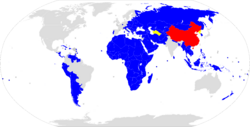 In 2013, China launched the ambitious Belt and Road infrastructure initiative, with over 150 countries announcing participation by the end of the decade. |
Europe
| Event | Country | Date | Description | References |
|---|---|---|---|---|
| Resignation of Silvio Berlusconi | 16 November 2011 | The longest-serving Prime Minister of Italy, Silvio Berlusconi, resigned in November 2011, after a sexual allegation scandal, a financial crisis and public protests. The economist Mario Monti was appointed new Prime Minister, at the head of a technocratic cabinet. | [295] | |
| 2012 Finnish presidential election | 22 January 2012 | Sauli Niinistö was elected the President of Finland for a term from 1 March 2012 until 2018.[296][297] | ||
| Diamond Jubilee of Elizabeth II | 6 February 2012 | Queen Elizabeth II celebrated her Diamond Jubilee, which marked the 60th anniversary of her accession. | [298] | |
| 2012 French presidential election | 22 April 2012 | François Hollande was elected as the new President of France, becoming the first socialist president of the country in 17 years. | [299] | |
| Resignation of Pope Benedict XVI and papal inauguration of Pope Francis | 28 February – 19 March 2013 | Benedict XVI resigned as pope, the first to do so since Gregory XII in 1415, and the first to do so voluntarily since Celestine V in 1294. On 13 March, after a papal conclave, Jorge Mario Bergoglio is inaugurated as Pope Francis, the first Jesuit pope, the first pope from the Americas, and the first non-European Pope in over 500 years. | [300][301] | |
| Death of Margaret Thatcher | 8 April 2013 | Margaret Thatcher, Prime Minister of the United Kingdom from 1979 to 1990, died. | [302] | |
| 2013 Italian presidential election | 20 April 2013 | Amid growing financial tensions, Italian President Giorgio Napolitano was re-elected, the first ever Italian president to be re-elected. Napolitano appointed Enrico Letta Prime Minister, at the head of a grand coalition. | [303] | |
| Annexation of Crimea by the Russian Federation | 18 March 2014 | Russia annexed the Crimean peninsula from Ukraine following an internationally unrecognised referendum on the status of the region. | [304] | |
| 2014 Scottish independence referendum | 18 September 2014 | In a referendum called by the governing Scottish National Party, Scotland voted to remain in the United Kingdom , with 55.3% of votes against independence while 44.7% voted in favour. | [305][306] | |
| Abdication of Juan Carlos I of Spain | 19 June 2014 | King Juan Carlos I of Spain abdicated in favour of his son, Felipe VI. | [307] | |
| 2015 Irish constitutional referendums | 23 May 2015 | The Republic of Ireland voted to legalise same-sex marriage, becoming the first country to legalise same-sex marriage by popular vote. | [308] | |
| Adoption of the Paris Agreement | 12 December 2015 | A historic agreement aimed at keeping global warming below 2 °C compared to pre-industrial levels and reducing greenhouse gas emissions is adopted by all 195 UNFCCC member states. | [309] | |
| 2016 United Kingdom European Union membership referendum | 23 June 2016 | In a referendum held in the United Kingdom on whether or not to continue being a member of the European Union, 52% of voters chose to leave it. Prime Minister David Cameron announced his resignation afterwards, being succeeded by Theresa May. | [310][311] | |
| 2016 Austrian presidential election | 4 December 2016 | Independent green Alexander Van der Bellen narrowly beat the far-right Freedom Party of Austria candidate Norbert Hofer in a repeat of the 2016 Austrian presidential election after the first election was annulled. | [312] | |
| 2017 French presidential election | 7 May 2017 | En Marche! candidate Emmanuel Macron was elected the President of France, replacing incumbent Hollande and defeating National Front candidate Marine Le Pen in the second round of voting. Macron is the youngest president in the history of the French Fifth Republic. | [313] | |
| Death of Helmut Kohl | 16 June 2017 | Helmut Kohl, former Chancellor of Germany from 1982 to 1998 (of West Germany 1982–1990 and of the reunited Germany 1990–1998), dies at the age of 87. | [314] | |
| 2017 Spanish constitutional crisis | 6 September 2017 | Political conflict sparks between the Spanish and the Catalan governments over the 2017 Catalan independence referendum. It still went ahead, with 91% of voters supporting independence within Catalonia, with unionists and Spain opposing the vote. On 27 October, Catalonia declares independence from Spain but it is not recognised by any sovereign nation, while Madrid imposes direct rule for 6 months.[315] | [316] | |
| 2018 Finnish presidential election | 28 January 2018 | Finnish Presidential elections were held in Finland on 28 January 2018. Incumbent Sauli Niinistö won reelection for his second consecutive term in office with 62,6 % of the vote. for a term from 1 March 2018 until 2024. | ||
| 2018 Italian general election | 4 March 2018 | The centre-right alliance, in which the right-wing populist League emerged as the main political force, won a plurality of seats in the Chamber of Deputies and in the Senate, while the anti-establishment Five Star Movement became the party with the largest number of votes. After months of negotiations, the two populist parties, M5S and League, formed a government. | [317][318] | |
| 2018 Russian presidential election | 18 March 2018 | Presidential elections were held in Russia on 18 March 2018. Incumbent Vladimir Putin won reelection for his second consecutive (fourth overall) term in office with 77% of the vote. | [319] | |
| 2019 European Parliament election | 23–26 May 2019 | The first European Parliamentary election following the European migrant crisis and the vote for Brexit saw large anti-establishment gains by the Greens-European Free Alliance and by Right-Wing Eurosceptic Parties within Identity and Democracy and European Conservatives and Reformists, such as League in Italy, Alternative for Germany, and National Rally in France. Other populist gains were seen in the success of the Brexit Party in the United Kingdom and the Five Star Movement in Italy. | [320] | |
| 2019 Conservative Party leadership election | 7 June – 22 July 2019 | The Conservative Party of the United Kingdom voted for Boris Johnson to be the party's new leader and prime minister following the resignation of Theresa May on 24 May 2019, the party's first contested leadership election since 2005. | [321] | |
| 2019 United Kingdom general election | 12 December 2019 | After an extended period of political deadlock over how to proceed with leaving the European Union an early general election took place in the United Kingdom in which the pro-withdrawal Conservative party won a sizeable majority of seats effectively guaranteeing Brexit would take place in January the following year. | [322] |
World leaders
- 2010 – 2011 – 2012 – 2013 – 2014 – 2015 – 2016 – 2017 – 2018 – 2019
Assassinations and attempts
Prominent assassinations, targeted killings, and assassination attempts include:
| Date | Description |
|---|---|
| 8 January 2011 | United States Federal judge John Roll and 5 others were killed and 13 more were injured in a shooting near Tucson. The apparent target, U.S. Representative Gabby Giffords, was critically injured in the head.[323] |
| 2 May 2011 | Osama bin Laden, the founder and leader of the militant Islamist group Al-Qaeda, was killed in a targeted killing in Abbottabad, Pakistan in an operation conducted by a team of United States Navy SEAL commandos.[324] |
| 30 September 2011 | Anwar al-Awlaki, a senior talent recruiter, planner and spiritual leader of al-Qaeda, was killed in a targeted killing in the northern al-Jawf province of Yemen, in a drone strike.[325] |
| 20 October 2011 | Muammar Gaddafi, leader of Libya, was shot to death in Sirte.[326] |
| 4 September 2012 | Pauline Marois, Premier-designate of Quebec, escaped death during her victory speech after Richard Henry Bain opened fire at the Metropolis in Montreal , killing one person and critically injuring another.[327] |
| 9 October 2012 | Malala Yousafzai, Pakistani women's rights activist, was the survivor of an assassination attempt by the Pakistani Taliban in Pakistan.[328] |
| 27 February 2015 | Boris Nemtsov, Russian physicist, statesman and opposition politician, was assassinated on the Bolshoy Moskvoretsky Bridge, Central Moscow, Russia , within sight of the Kremlin.[329] |
| 16 June 2016 | Jo Cox, British MP, was shot and stabbed to death by a Neo-Nazi white supremacist[330] in Birstall, England . She was the first British MP assassinated in over a quarter of a century and the first female politician in Britain to be assassinated.[331] |
| 19 December 2016 | Andrei Karlov, the Russian ambassador to Turkey, was shot to death by an off duty police officer at an art gallery in Ankara.[332] |
| 13 February 2017 | Kim Jong-nam, eldest son of the late Kim Jong-il, was assassinated by two women in Malaysia with a VX nerve agent.[333] |
| 14 June 2017 | Steve Scalise, an American Congressman, is shot and injured during practice ahead of the annual Congressional Baseball Game in Alexandria, Virginia by a man who held grievances against the Republican party. Three others are also injured.[334] |
| 4 March 2018 | Sergei Skripal, a former Russian double agent, was poisoned alongside his daughter Yulia in the city of Salisbury with a Novichok agent.[335] |
| 2 July 2018 | Antonio Halili, Mayor of Tanauan, Batangas, was assassinated by an unidentified gunman while attending a flag raising ceremony together with around 300 government employees and newly elected barangay officials.[336] |
| 2 October 2018 | Jamal Khashoggi, Saudi Arabian dissident and journalist for The Washington Post, was assassinated in the Saudi Arabian consulate by the Saudi Government in Istanbul, Turkey in what is widely believed to have been ordered directly by Crown Prince Mohammed bin Salman.[337][338][339] |
| 13 January 2019 | Paweł Adamowicz, Mayor of the city of Gdańsk, was stabbed during a live charity event in Gdańsk by a former inmate. He died the following day.[340] |
| 27 October 2019 | Abu Bakr al-Baghdadi, the leader of ISIL, was killed during a raid by U.S. special forces in northwestern Syria.[341] |
Disasters
Non-natural disasters
Aviation
| Event | Date | Country | Description | References |
|---|---|---|---|---|
| Ethiopian Airlines Flight 409 | 25 January 2010 | Ethiopian Airlines Flight 409 crashed into the Mediterranean Sea shortly after take-off from Beirut Rafic Hariri International Airport, killing all 90 people on board. | [342] | |
| 2010 Polish Air Force Tu-154 crash | 10 April 2010 | Polish President Lech Kaczyński and dozens of Polish government and military officials were among 96 people killed when their plane crashed near Smolensk, Russia . | [343] | |
| Afriqiyah Airways Flight 771 | 12 May 2010 | Afriqiyah Airways Flight 771 crashed on a runway at Tripoli International Airport in Libya, killing all but one of the 104 passengers and crew. | [344] | |
| Air India Express Flight 812 | 22 May 2010 | Air India Express Flight 812 overshot the runway at Mangalore International Airport in India, killing 158 people, with eight surviving. | [345] | |
| Airblue Flight 202 | 28 July 2010 | Airblue Flight 202 en route from Karachi to Islamabad crashed in the Margalla Hills near Islamabad, killing all 152 aboard, becoming the deadliest air crash in Pakistan's history. | [346] | |
| Dana Air Flight 992 | 3 June 2012 | Dana Air Flight 992 crashed in the Nigerian city of Lagos, killing all 153 people aboard. 10 people on the ground also perished. | [347] | |
| Asiana Airlines Flight 214 | 6 July 2013 | Asiana Airlines Flight 214 crashed at San Francisco airport killing 3 and injuring 181 people. | [348] | |
| Malaysia Airlines Flight 370 | 8 March 2014 | Malaysia Airlines Flight 370 vanished en route from Kuala Lumpur to Beijing. The bulk of the plane is still missing, with all 239 people on board presumed dead. The first remains of the aircraft were found on 29 July 2015, after they washed ashore on Réunion Island. | [349][350] | |
| Malaysia Airlines Flight 17 | 17 July 2014 | Malaysia Airlines Flight 17 was shot down over Donetsk Oblast, Ukraine and crashed near the Ukrainian-Russian border, killing all 298 people on board, making it the deadliest airliner shoot down in history. | [351] | |
| Air Algérie Flight 5017 | 24 July 2014 | Air Algérie Flight 5017 crashed in southern Mali, killing all 116 passengers and crew. | [352] | |
| Indonesia AirAsia Flight 8501 | 28 December 2014 | Indonesia AirAsia Flight 8501 crashed in the Java sea after an attempt to avoid heavy thunderstorms, leaving all 162 people dead. | [353] | |
| Germanwings Flight 9525 | 24 March 2015 | Germanwings Flight 9525 crashed in the French Alps, killing all 150 on board. | [354] | |
| 2015 Indonesian Air Force Lockheed C-130 Hercules crash | 30 June 2015 | A Lockheed C-130 Hercules operated by the Indonesian Air Force crashed into a crowded residential neighbourhood in Medan shortly after take-off from Soewondo Air Force Base, killing 143 people including 22 on the ground, making it the deadliest crash in Indonesian Air Force peacetime history. | [355] | |
| Metrojet Flight 9268 | 31 October 2015 | Metrojet Flight 9268, an Airbus A321 airliner en route to Saint Petersburg from Sharm el-Sheikh, crashes near Al-Hasana in Sinai, killing all 224 passengers and crew on board. | [356] | |
| LaMia Flight 2933 | 29 November 2016 | A chartered Avro RJ85 plane carrying 77 people, including the Chapecoense football team, crashes near Medellín, Colombia. Six of the passengers survived. The 2016 Copa Sudamericana Finals were suspended, and Atlético Nacional, Chapecoense's to-be opponents, gave them the trophy out of respect. | [357] | |
| 2016 Russian Defence Ministry Tupolev Tu-154 crash | 25 December 2016 | A Tupolev Tu-154 crashes near Sochi, Russia, killing all 92 people on board, including 64 members of the Alexandrov Ensemble. | [358] | |
| Iran Aseman Airlines Flight 3704 | 18 February 2018 | Iran Aseman Airlines Flight 3704 crashes in the Zagros Mountains, en route from Tehran to Yasuj. All 65 passengers and crew members perish. | [359] | |
| Cubana de Aviación Flight 972 | 18 May 2018 | Cubana de Aviación Flight 972 crashes shortly after take-off near José Martí International Airport in Havana, killing 112 and leaving only one survivor. | [360] | |
| Lion Air Flight 610 | 29 October 2018 | Lion Air Flight 610 crashes off the coast of Java, with 189 passengers on board. | [361] | |
| Ethiopian Airlines Flight 302 | 10 March 2019 | Ethiopian Airlines Flight 302, a Boeing 737 MAX 8 bound for Nairobi, crashes shortly after takeoff from Addis Ababa killing all 157 people on board. | [362] | |
| Aeroflot Flight 1492 | 5 May 2019 | Aeroflot Flight 1492 makes a hard landing, causing fire and partial destruction at Sheremetyevo International Airport, Moscow, killing 41 of the 78 people on board. | [363] |
General
| Event | Date | Country | Description | References |
|---|---|---|---|---|
| 2010 Copiapó mining accident | 13 October 2010 | Thirty-three miners near Copiapó, Chile, were trapped 700 metres (2,300 feet) underground in a mining accident in San José Mine, before being rescued after surviving for a record 69 days. | [364] | |
| 2013 Savar building collapse | 24 April 2013 | An eight-story factory building collapsed in the outskirts of Dhaka, Bangladesh, killing 1,129 people and injuring over 2,000 more, becoming the deadliest structural failure in history. | [365] | |
| 2015 Tianjin explosions | 12 August 2015 | Two explosions occurred within 30 seconds of each other at a container storage station at the Port of Tianjin in the Binhai New Area of Tianjin, China, killing at least 173. | [366] | |
| Mecca crane collapse | 11 September 2015 | A crane toppled over at Mecca, killing 111 people, weeks before the official Hajj pilgrimage. | [367] | |
| 2015 Mina stampede | 24 September 2015 | A stampede during the Hajj pilgrimage in Mecca, Saudi Arabia, killed at least 2,236 people, making it the deadliest Hajj disaster in history. | [368] | |
| Bento Rodrigues dam disaster | 5 November 2015 | An iron ore tailings dam in Bento Rodrigues, a subdistrict of Mariana, Brazil, suffered a catastrophic failure, causing flooding and at least 17 deaths. At least 16 people have been injured. This incident has been described as the worst environmental disaster in Brazil's history. | [369][370][371] | |
| Tham Luang cave rescue | 23 June – 10 July 2018 | Twelve boys and their football coach are rescued from the flooded Tham Luang Nang Non cave in Thailand, following a 17-day ordeal that gained worldwide attention. | [372][373] | |
| Ponte Morandi Collapse | 14 August 2018 | Part of the Morandi Bridge collapses after a violent storm in Genoa, Italy, causing 43 fatalities. Deputy Prime Minister Luigi Di Maio and transport minister Danilo Toninelli blame private company Autostrade per l'Italia. | [374][375] | |
| Tlahuelilpan pipeline explosion | 18 January 2019 | A gasoline pipeline exploded in the town of Tlahuelilpan, in the Mexican state of Hidalgo. The blast killed at least 135 people and injured dozens more. Mexican authorities blamed fuel thieves, who had illegally tapped the pipeline. | [376] | |
| 2019 Xiangshui chemical plant explosion | 21 March 2019 | A major explosion at a chemical plant in Xiangshui, Jiangsu, China, kills at least 64 people and injures more than 600 others. Its powerful impact registered as an artificial earthquake. | [377] |
Fires
| Event | Date | Country | Description | References |
|---|---|---|---|---|
| Comayagua prison fire | 14–15 February 2012 | A fire at the National Penitentiary in Comayagua, Honduras killed 361 people. | [378][379] | |
| 2012 Dhaka garment factory fire | 24 November 2012 | 117 people were confirmed dead in a garment factory fire, and over 200 were injured, making it the deadliest factory fire in the nation's history. | ||
| Kiss nightclub fire | 27 January 2013 | 242 people were killed in a fire at a nightclub in Santa Maria, Brazil . | [380] | |
| Colectiv nightclub fire | 30 October 2015 | 64 people were killed in a fire at a nightclub in Bucharest, Romania. | ||
| Ghost Ship warehouse fire | 2 December 2016 | 36 were killed in an artists' live-and-work collective in an Oakland, CA accident due to substandard wiring. | ||
| Grenfell Tower fire | 14 June 2017 | A fire ignited by a faulty refrigerator in a London council estate tower block spread to almost the entirety of the building causing 72 deaths and over 70 injuries. | [381][382] | |
| 2018 Kemerovo fire | 25 March 2018 | 60 people die in a fire at a shopping and entertainment complex in the Russian city of Kemerovo. | [383] | |
| 2018 Valencia, Venezuela fire | 28 March 2018 | At least 78 people die in a fire in the police headquarters of Valencia, Venezuela. | [384] | |
| National Museum of Brazil fire | 2 September 2018 | A fire destroys the National Museum of Brazil in Rio de Janeiro. No one was injured, but 90 percent of the collection was destroyed. | [385][386] | |
| February 2019 Dhaka fire | 20 February 2019 | A major fire in Dhaka, Bangladesh kills at least 78 people. | [387] | |
| Notre-Dame de Paris fire | 15 April 2019 | A major fire at the Notre-Dame Cathedral destroyed most of its roof, and its upper walls were severely damaged; extensive damage to the interior was prevented by its stone vaulted ceiling, which largely contained the burning roof as it collapsed. 3 injuries were reported, but there were no confirmed deaths. | [388] |
Marine
| Event | Date | Country | Description | References |
|---|---|---|---|---|
| Costa Concordia disaster | 13 January 2012 | The Italian cruise ship Costa Concordia hit a reef and partially capsized off the coast of Isola del Giglio, Italy, killing 32 people. | [389] | |
| Sinking of MV Sewol | 16 April 2014 | South Korean ferry MV Sewol capsized while en route to Jeju, killing 295 people, mostly secondary school students from Danwon High School. | [390] | |
| Sinking of Dongfang zhi Xing | 1 June 2015 | The river cruise ship Dongfang zhi Xing capsized in the Yangtze River after being hit by a waterspout, killing 442 people, making it the deadliest maritime disaster in China 's peacetime history. | [391] | |
| Sinking of MV Nyerere | 20 September 2018 | The MV Nyerere capsizes on Lake Victoria, killing at least 227 passengers. | [392] |
Pollution
| Event | Date | Country | Description | References |
|---|---|---|---|---|
| Deepwater Horizon oil spill | 20 April 2010 | An explosion on BP's Deepwater Horizon offshore drilling rig, operating in the Gulf of Mexico off the coast of Louisiana, left eleven crewmen dead and resulted in a fire that sank the rig and caused a massive oil spill, becoming the worst environmental disaster in U.S. history. | [393][394] | |
| Fukushima Daiichi nuclear disaster | 11 March 2011 | A magnitude 9.0 earthquake off the coast of Sendai caused a tsunami that severely damaged the Fukushima Daiichi and Fukushima Daini nuclear power plants. The damage resulted in the worst nuclear disaster since the Chernobyl disaster, contaminating the entire area. | [395][396] | |
| Flint water crisis | 25 April 2014 | The U.S. city of Flint, Michigan's water source was changed from the treated Detroit Water and Sewerage Department to the Flint River, where officials had failed to apply corrosion inhibitors. This decision led to the water being contaminated by lead and eventual nationwide outrage about an alleged coverup. | [397][398] |
Natural disasters
Earthquakes and tsunamis
| Event | Date | Country | Description | References |
|---|---|---|---|---|
| 2010 Haiti earthquake | 12 January 2010 | A 7.0 magnitude earthquake hit Haiti, causing widespread destruction in Port-au-Prince. Haitian authorities believe that the disaster killed between 200,000 and 250,000 people and over three million more were affected by the quake. The earthquake was the deadliest disaster in the decade. | [399][400] | |
| 2010 Chile earthquake | 27 February 2010 | An 8.8 magnitude earthquake occurred in Chile , triggering a tsunami across the Pacific and killing 497. One of the largest earthquakes in recorded history, this rare megathrust earthquake likely shifted Earth's axis and slightly shortened its days. | ||
| 2010 Baja California earthquake | 4 April 2010 | A 7.2 magnitude earthquake hit Mexicali and Baja, killing three and injuring more than two hundred. US border towns in Imperial Valley, California were affected. | [401] | |
| 2010 Yushu earthquake | 13 April 2010 | A 6.9 magnitude earthquake occurred in western China, killing at least 2,200 and injuring more than 12,000. | [402][403] | |
| February 2011 Christchurch earthquake | 22 February 2011 | A 6.3 magnitude earthquake struck Christchurch, New Zealand, killing 185 people. | [404] | |
| 2011 Tōhoku earthquake and tsunami | 11 March 2011 | A 9.0 magnitude earthquake hit near Sendai, Japan. It created a 30 feet (9.1 m) high tsunami, leaving 15,893 dead, 2,565 missing and over 150,000 displaced. It was the largest earthquake to hit Japan in 140 years. | [405][406][407] | |
| 2011 Van earthquake | 23 October 2011 | A 7.1 magnitude earthquake struck the Turkish city of Van, leaving over 604 dead and thousands more injured. | [408] | |
| April 2015 Nepal earthquake | 25 April 2015 | A massive 7.8 magnitude earthquake in Nepal killed at least 8,857 people and injured tens of thousands more. It is the worst disaster to hit Nepal in decades. | [409][410][411] | |
| May 2015 Nepal earthquake | 12 May 2015 | A second major earthquake hit Nepal, measuring 7.3 on the moment magnitude scale, killing 218 more people. | [412] | |
| 2016 Ecuador earthquake | 16 April 2016 | A 7.8 earthquake struck near Muisne, Ecuador, killing over 673 people and displacing at least 25,000 more. | [413] | |
| August 2016 Central Italy earthquake | 24 August 2016 | A 6.2 magnitude earthquake struck Central Italy near Norcia, 75 km (47 mi) southeast of Perugia and 45 km (28 mi) north of L'Aquila, in an area near the tripoint of the Umbria, Lazio, and Marche regions. At least 299 people were left dead. | [414] | |
| 2017 Central Mexico earthquake | 19 September 2017 | A 7.1 magnitude earthquake struck near the city of Puebla. Coincidentally, it was also the 32nd anniversary of the 1985 Mexico City earthquake, which was commemorated with a national seismic alert drill, just two hours before the real earthquake struck, which left 360 dead and over 6,000 injured. | [415] | |
| 2018 Sulawesi earthquake and tsunami | 28 September 2018 | A magnitude 7.5 earthquake hits Sulawesi, Indonesia, causing a tsunami that kills at least 2,256 people and injures more than 540 others. | [416] | |
| 2018 Sunda Strait tsunami | 22 December 2018 | A tsunami hits the Sunda Strait, Indonesia after a volcanic eruption of Anak Krakatoa killing at least 430 people and injuring nearly 1,500. | [417] | |
| 2019 Peru earthquake | 26 May 2019 | An 8.0 magnitude earthquake struck in Loreto Region, Peru, killing 2 people and injures more than 30 others. | [418] | |
| 2019 Albania earthquake | 26 November 2019 | A 6.4 magnitude earthquake hits Albania near the cities of Durrës and Tirana, killing 51 people and injuring over 3,000 others. | [419] |
Tropical cyclones
| Event | Date | Country | Description | References |
|---|---|---|---|---|
| Typhoon Megi | 18 October 2010 | Typhoon Megi, known in the Philippines as Super Typhoon Juan, hit the Philippines, killing at least 69 and causing US$709 million in damage. | [420] | |
| Hurricane Irene | 22 August 2011 | Hurricane Irene, the first hurricane and major hurricane of the 2011 Atlantic hurricane season,
caused devastation on various islands in the Caribbean and the East Coast of the United States, killing 49 and causing almost $14.2 billion in damages. | ||
| Tropical Storm Washi | 16 December 2011 | Tropical Storm Washi, known in the Philippines as Tropical Storm Sendong, caused catastrophic damage on the Philippines island of Mindanao. More than 1,000 died and thousands were injured or missing. | [421] | |
| Hurricane Sandy | 25 October 2012 | Various | Hurricane Sandy caused immense destruction in Cuba, Jamaica, Puerto Rico and the United States, leaving at least 233 dead. It became the largest Atlantic tropical storm ever. | [422] |
| Typhoon Bopha | 2 December 2012 | Typhoon Bopha, known in the Philippines as Typhoon Pablo, struck the Philippines , killing at least 650 people and leaving millions more homeless. | [424] | |
| Typhoon Haiyan | 7 November 2013 | Typhoon Haiyan, known as Super Typhoon Yolanda in the Philippines, hits the Philippines, killing at least 6,000 people, with a thousand more still missing, making it the deadliest typhoon to ever hit the Philippines. | [425] | |
| Hurricane Joaquin | 28 September 2015 – 7 October 2015 | Hurricane Joaquin was a powerful tropical cyclone that devastated several districts of the Bahamas and caused damage in the Turks and Caicos Islands, parts of the Greater Antilles, and Bermuda. | [426] | |
| Typhoon Melor | 13 December 2015 | Typhoon Melor, known in the Philippines as Typhoon Nona, hits the Philippines, killing 42 and causing $136 million in damages. | [427][428] | |
| Cyclone Winston | 20 February 2016 | Cyclone Winston struck Fiji, killing 44 people and causing $1.4 billion in damages, making it the costliest tropical cyclone in South Pacific history. | [429] | |
| Hurricane Matthew | 28 September 2016 – 9 October 2016 | Hurricane Matthew caused catastrophic damage and a humanitarian crisis in Haiti, as well as widespread devastation in the southeastern United States. The deadliest Atlantic hurricane since Hurricane Stan in 2005, it caused extensive damage to landmasses in the Greater Antilles, severe damage in several islands of the Bahamas and was responsible for 603 fatalities. | [430] | |
| Hurricane Harvey | 23 August 2017 | Hurricane Harvey slams into southeastern Texas after reorganising over the Gulf of Mexico, causing catastrophic flooding and billions in damages. It became the first major hurricane to make landfall in the United States since Hurricane Wilma in 2005. Total damage from the hurricane was estimated at $125 billion, making it the costliest natural disaster ever in the United States, tied with 2005's Hurricane Katrina. | [431][432] | |
| Hurricane Irma | 30 August 2017 – 16 September 2017 |
|
Hurricane Irma, an extremely powerful and catastrophic Cape Verde-type hurricane, the strongest observed in the Atlantic since Wilma in 2005 in terms of maximum sustained winds. It was the first Category 5 hurricane to strike the Leeward Islands on record. The storm caused catastrophic damage in Barbuda, Saint Barthélemy, Saint Martin, Anguilla, and the Virgin Islands as a Category 5 hurricane. | [433][434] |
| Hurricane Maria | 16 September 2017 – 3 October 2017 | Hurricane Maria is regarded as the worst natural disaster on record in Dominica, and caused catastrophic damage and a major humanitarian crisis in Puerto Rico. The third costliest Atlantic hurricane to date, it caused catastrophic damage and thousands of fatalities across the northeastern Caribbean, compounding recovery efforts in areas still damaged from Hurricane Irma just two weeks prior. | [435][436] | |
| Typhoon Mangkhut | 15 September 2018 | Typhoon Mangkhut, known in the Philippines as Typhoon Ompong, hits northern Luzon, triggering deadly landslides and killing at least 95 people. | [437][438] | |
| Hurricane Michael | 7 October 2018 – 16 October 2018 | Hurricane Michael was the first Category 5 hurricane to strike the contiguous United States since Andrew in 1992. In addition, it was the third-most intense Atlantic hurricane to make landfall in the contiguous United States in terms of pressure, behind the 1935 Labor Day hurricane and Hurricane Camille of 1969. It was the first Category 5 hurricane on record to impact the Florida Panhandle, and was the fourth-strongest landfalling hurricane in the contiguous United States, in terms of wind speed. Michael was responsible for 74 deaths. | [439] | |
| Hurricane Dorian | 24 August 2019 – 10 September 2019 | Hurricane Dorian was one of the strongest Atlantic hurricanes in years, and also is tied as the strongest landfalling Atlantic hurricane since the 1935 Labor Day Hurricane. Dorian also became the worst natural disaster in all of the Bahamas' history, killing over 73 people and causing over US$4.68 billion in damage, with US$3.4 billion of damage in The Bahamas alone after the storm stalled over Grand Bahama at incredible Category 5 intensity. The storm also caused 1.2 billion dollars of damage in the United States after making landfall near Cape Hatteras, North Carolina. | [440] |
Tornadoes
| Event | Date | Country | Description | References |
|---|---|---|---|---|
| 2011 Super Outbreak | 25–28 April 2011 | A tornado outbreak in the United States and Canada killed 324 people across six states. At 360 tornadoes, it was the largest and one of the deadliest tornado outbreaks in United States history. | [441] | |
| 21–26 May 2011 tornado outbreak sequence | 21 May 2011 | Another U.S. tornado outbreak took place over six days. 178 people were killed, most of which occurred in Joplin, Missouri after an EF5 tornado swept through the city, killing 158 people and injuring at least 1,150. | [442] | |
| 2019 Nepal tornado | 31 March 2019 | A tornado struck the Bara and Parsa districts of Nepal, killing 28 and injuring 1,176 people. It is the first officially recorded tornado in Nepalese history. | [443] |
Floods, avalanches, and mudslides
| Event | Date | Country | Description | References |
|---|---|---|---|---|
| 2010 Pakistan floods | July 2010 | Flooding occurred in Pakistan after record monsoon rains, killing at least 1,600 people, thousands were rendered homeless, and more than thirteen million people were affected. Estimates from rescue service officials suggest the death toll might have reached 3,000. | [444][445][446] | |
| January 2011 Rio de Janeiro floods and mudslides | 11 January 2011 | Floods and mudslides killed 903 people across the state of Rio de Janeiro, Brazil . | [447][448] | |
| 2013 Alberta floods | 19 June 2013 | Massive flooding occurred in Alberta, becoming the province's worst flooding in decades. | [449] | |
| 2014 Southeast Europe floods | 13–27 May 2014 |
|
Between 13 and 18 May 2014 a low pressure cyclone designated "Tamara" and "Yvette" affected a large area of Southeastern and Central Europe, causing floods and landslides. Serbia and Bosnia and Herzegovina suffered the greatest damage as the rain was the heaviest in 120 years of recorded weather measurements. At least 86 people were killed and hundreds of thousands had been forced from their homes. Assessments of damage range up to 3.5 billion euros for Serbia, Bosnia and Herzegovina. | |
| 2015 Afghanistan avalanches | 24 February 2015 | An avalanche killed 310 people and wounded over 129 in Panjshir Province, Afghanistan. | [450] | |
| 2015 South Indian floods | 8 November 2015 | Heavy rainfall generated by the annual northeast monsoon affected the Coromandel Coast region of the South Indian states of Tamil Nadu and Andhra Pradesh. More than 500 people were killed and over 1.8 million people were displaced. With estimates of damages and losses ranging from nearly ₹200 billion (US$3 billion) to over ₹1 trillion (US$14 billion), the floods were the costliest to have occurred in 2015, and were among the costliest natural disasters of the year. | [451] |
Volcanic eruptions
| Event | Date | Country | Description | References |
|---|---|---|---|---|
| 2010 eruptions of Eyjafjallajökull | 20 March 2010 | Eruptions of the Eyjafjallajökull volcano in Iceland caused unprecedented disruption to international air travel, rendering transatlantic flight impossible and closing airways across much of Europe. The event was the largest air traffic shut-down since World War II. | [452] | |
| 2010 eruptions of Mount Merapi | Early November 2010 | Mount Merapi erupted in Indonesia, killing 353 people and grounding flights across Southeast Asia, becoming the largest eruption from the mountain in a century. | ||
| 2018 lower Puna eruption | 3 May 2018 | A lava flow erupted in Hawai'i from Kīlauea's east rift zone, causing much damage and resulting in evacuation orders. | ||
| 2018 Volcán de Fuego eruption | 3 June 2018 | Volcán de Fuego erupted in Guatemala, killing at least 190 people, the deadliest eruption in Guatemala since 1929. | ||
| 2019 Whakaari/White Island eruption | 9 December 2019 | Whakaari/White Island, an active stratovolcano off the east coast of New Zealand's North Island, erupted, killing 20 people. | [453] |
Droughts, heat waves, and wildfires
| Event | Date | Country | Description | References |
|---|---|---|---|---|
| 2011–17 California drought | December 2011 – March 2017 | The state of California suffered through a water drought for the most part of the decade, affecting the way how Californians showered, use their drinking water, and even some of their electricity. | [454] | |
| 2015 Indian heat wave | 24 May 2015 | A heatwave in Southern India resulted in over 2,500 deaths. | [455] | |
| 2015 Pakistani heat wave | 20 June 2015 | A related heatwave hit neighbouring Pakistan , killing over 2,000 people in Karachi alone. | [455] | |
| 2016 Fort McMurray wildfire | 1 May 2016 | A wildfire began southwest of Fort McMurray, Alberta, Canada. On 3 May, it swept through the community, destroying more than 2,400 homes and buildings and forcing the largest wildfire evacuation in Alberta's history. The wildfire is the costliest disaster in Canadian history. | [456][457] | |
| 2018 Camp Fire | 8–25 November 2018 | A wildfire began in Northern California that eventually became the deadliest and most destructive wildfire in California history to date. It was also the deadliest wildfire in the United States since the Cloquet fire in 1918, and among the list of deadliest wildfires, it was the sixth-deadliest U.S. wildfire overall, killing 85 people and injuring 17. | [458][459] | |
| 2019 Amazon rainforest wildfires | January 2019 – October 2019 | Template:Country data Perù |
The 2019 wildfires season saw an unusual surge in the number of fires occurring in the Amazon rainforest and other parts of the Amazon biome contained within the countries of Brazil , Bolivia, Paraguay, and Peru during the 2019 Amazonian tropical dry season. | [460][461] |
| 2019–20 Australian bushfires | August 2019 – June 2020 | The 2019 Australian bushfire season arrived in the wake of heavy droughts across the country, with fires covering the east coast including the metropolitan confines of Sydney. There were 34 direct fatalities and hundreds of properties destroyed. Subsequent smoke covered the city of Sydney and Melbourne, causing toxic air pollution. | [462][463][464][465] |
Economics

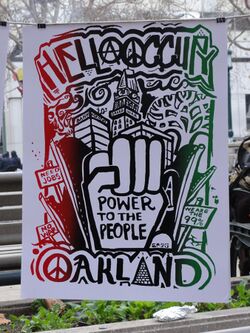

The global economy during the 2010s was generally strong. It saw steady growth, low unemployment, and increasing consumer confidence recovering from the great recession. The decade ended with a strong finish, with 2019 seeing record highs in many areas. A sovereign-debt crisis in Europe began in early 2010, and the Greek government admitted that it was having difficulties servicing its large sovereign debt. In the summer and fall of 2011, bond yields for Italy and Spain spiked above 6 percent.[466] By 2015 bond rates had returned to normal ranges across Europe, save for Greece, which accepted another, even more stringent bailout package. The size of the European Financial Stability Facility was increased from €440 billion to €2 trillion.[467] Despite the Eurozone debt crisis, the American Dow Jones Industrial Average had its longest stretch of gains since the late 1990s tech boom.[468] However, economic issues, including inflation and an increase in commodity prices, sparked unrest in many lower-income countries. In some countries, particularly those in the Arab world, political unrest evolved into socioeconomic crises, resulting in the Arab Spring leading to political instability and civil wars.
As a result of the global recession, many central banks instituted a zero interest-rate policy, or close to it.[469] Another form of monetary stimulus was that of quantitative easing. The resulting flood of market liquidity caused a rise in asset prices.[470] As a result, for example, United States stock prices reached record highs.[471] Another consequence has been the rise in housing prices in many major world cities.[472] Some of the cities which recorded the most dramatic rises included Sydney, San Francisco , Vancouver , and Auckland.[473]
In 2010, China became the second largest global economy, surpassing Japan.[474] Japan also saw a rating downgrade the following year due to debt burden.[475] In August 2011, the S&P downgraded the United States ' credit rating from triple AAA to AA-plus following a debt ceiling crisis.[476] Also in 2011, a Gallup poll found that more than half of Americans believed the country was still in a recession.[477] In June 2015, the Shanghai Stock Exchange lost a third of the value of A-shares within one month, an event known as the 2015–16 Chinese stock market turbulence. India became the fastest growing major economy of the world in 2015, surpassing China.[478] In 2018, as the U.S. Federal Reserve raised interest rates, fears of a yield curve inversion preceding a potential U.S. recession sent inflation higher in several emerging markets, including Argentina , where interest rates hit 40% and an International Monetary Fund bail out was issued.[479] In 2019, Singapore supplanted the United States as the world's most competitive economy, with the U.S. dropping to third, behind Hong Kong.[480]
Global oil production in 2014 reached a historic peak, reaching 93 million barrels/day.[481] In 2018, partially due to a shale boom, the United States overcame Russia and Saudi Arabia in becoming the world's largest crude oil producer, the first time since 1973.[482] Around the year 2017 is a period seen by some economists as being the new peak of a "goldilocks economy".[483] The International Monetary Fund's April 2019 World Economic Outlook stated, "After peaking at close to 4 percent in 2017, global [economic] growth remained strong, at 3.8 percent in the first half of 2018, but dropped to 3.2 percent in the second half of the year."[484]
In 2018, United States President Donald Trump announced he would put into place new tariffs on some Chinese products, starting the 'US-China Trade War', an economic conflict involving the world's two largest economies. Trump said the reasoning for the trade war is to punish China for 'unfair' trade practices, such as the appropriation of jobs and the theft of American intellectual property. China responded with tariffs of its own, and a cycle began, escalating the conflict to the situation faced today. As part of his 'America First' policy, Trump also announced new tariffs were being placed on countries around the world for various products such as steel and aluminium, which has drawn some economic retaliation.
By the end of the decade, in North American and some Western European domestic economies, consumer-level purchasing habits had shifted significantly, a partial consequence of the Great Recession's impact on discretionary incomes and a shifting breadwinner model. The so-called "retail apocalypse" had commenced as consumers increasingly resorted to online shopping and e-commerce, accelerating the decline of brick-and-mortar retail and the continued decline of indoor shopping malls. The transitioning retail industry and popularity of online shopping facilitated economic phenomena such as bricks and clicks business models, pop-up and non-store retailing, drone delivery services, ghost restaurants, and a quickly maturing online food ordering and delivery service sector.[485][486] This was only further perpetuated by the rise in cryptocurrency throughout the decade, such as Bitcoin. By May 2018, over 1,800 cryptocurrency specifications existed.[487]
In the same vein as cryptocurrency, the trend towards a cashless society continued as non-cash transactions and digital currency saw an increase in favourability in the 2010s. By 2016, only about 2 percent of the value transacted in Sweden was by cash, and only about 20 percent of retail transactions were in cash. Fewer than half of bank branches in the country conducted cash transactions.[488] A report published in 2019 suggested that the percentage of payments conducted in cash in the United Kingdom had fallen to 34% from 63% from 2009.[489] The 2016 United States User Consumer Survey Study claimed that 75 percent of respondents preferred a credit card or debit card as their payment method while only 11 percent of respondents preferred cash.[490]
Science and technology
Two of the most prominent deaths in the scientific community during the decade were Neil Armstrong in 2012 and Stephen Hawking in 2018.
Below are the most significant scientific developments of each year, based on the annual Breakthrough of the Year award of the American Association for the Advancement of Science journal Science.
- 2010: The first quantum machine[491]
- 2011: HIV treatment as prevention (HPTN 052)[492]
- 2012: Discovery of the Higgs boson[493]
- 2013: Cancer immunotherapy[494]
- 2014: Rosetta comet mission[495]
- 2015: CRISPR genome-editing method[496]
- 2016: The Laser Interferometer Gravitational-Wave Observatory makes the first observation of gravitational waves, fulfilling Einstein's prediction[497]
- 2017: Cosmic convergence: Neutron star merger (GW170817)[498]
- 2018: Development cell by cell[499]
- 2019: First black hole image released[500][501]
Technology
The late 2000s saw the rise of two prominent mobile operating systems, the Android developed by Google and the iOS developed by Apple.
Robotics, particularly drones like quadcopters, experienced a wide use and application in the 2010s. Autonomous and electric car technology and sales showed considerable growth as well. In addition, sustainable space launch technologies were spearheaded by entrepreneurs like Elon Musk.
In 2016, the number of people globally using mobile devices to access the internet overtook those using desktop computers for the first time, having been preceded by the U.S. two years prior in 2014.[502][503][504][505][506] 3D printers also emerged in the 2010s and were referenced or used in pop culture during the decade.
In 2018, during the Falcon Heavy test flight, the first production car was launched into space. The car was attached to the Falcon Heavy rocket, the most powerful rocket in operation at the time.
The 2010s saw the release of smaller and earlier iPhone iterations, as during the 2010s newer smartphones began to replace Clamshell designed phones. Phones of the 2010s mostly saw the usage of 3G and 4G technologies.
Cyber security and hacking
Cyber security incidents, such as hacking, leaks or theft of sensitive information, gained increased attention of governments, corporations and individuals.

| Event | Date | Description |
|---|---|---|
| Afghan War documents leak | 25 July 2010 | WikiLeaks published more than 90,000 internal U.S. military logs of the War in Afghanistan. The documents revealed numerous cover-ups and absence of trials for captured or killed Taliban members by the coalition.[507] |
| Stuxnet | August 2010 | A malicious computer worm was responsible for causing substantial damage to Iran's nuclear program. Although neither country has admitted responsibility, the worm is now generally acknowledged to be a jointly built U.S.-Israeli cyberweapon.[508] |
| Iraq War documents leak | 22 October 2010 | WikiLeaks disclosed nearly 392,000 U.S. Army field reports of the Iraq War, the largest leak in the history of the U.S. military. It documented multiple cases of misconduct, abuse of power against civilians and other war crimes by U.S. authorities in the country.[509] |
| The Offshore leaks | April 2013 | A report disclosed details of 130,000 offshore accounts, with some observers calling it one of the biggest hit against international tax fraud of all time. The report originated from the Washington D.C. investigative journalism nonprofit, the International Consortium of Investigative Journalists (ICIJ).[510] |
| Global surveillance disclosures (2013–present) | 5 June 2013 | Edward Snowden leaked files through the Guardian newspaper detailing National Security Agency (NSA) privacy policies, including PRISM, the NSA call database, and Boundless Informant.[511] |
| Office of Personnel Management data breach | 5 June 2015 | The Office of Personnel Management of the U.S. government announced that it was hacked, resulting in a massive data breach, stealing information of around 21.5 million people.[512] The attack was suspected to have originated from China but it remains unclear if it was or not.[513] |
| 2016 Bangladesh Bank heist | 4 February 2016 | The Bangladesh Bank became a victim of theft after hackers attempted to steal US$951 Million from its account at the Federal Reserve Bank of New York.[514] The hackers failed to steal the attempted amount but still got away with $81 million, which was diverted to the Philippines, making it one of the largest bank heists in history.[515] |
| Panama Papers | 3 April 2016 | 11.5 million confidential documents were leaked from the Panamanian law firm Mossack Fonseca that detailed financial and attorney–client information of more than 214,488 offshore companies. The leaks revealed information of various prominent figures being involved in hidden financial dealings within tax havens and companies doing business with terrorist organisations and governments under international sanctions.[516] |
| Yahoo! data breach | 22 September 2016 | Yahoo Inc. reported that account information for up to 500 million users in 2014 had been hacked, compromising personal data from the accounts, including names, addresses, passwords, telephone numbers and possibly encrypting other information.[517] |
| October 2016 Dyn cyberattack | 21 October 2016 | A currently unknown attacker launches multiple distributed denial-of-service (DDos) attacks on networks operated by DNS provider Dyn, making numerous sites difficult or impossible to access for a period of time, including Twitter, Reddit, Netflix, Spotify, The New York Times , BBC News, and PayPal. The Department of Homeland Security opens an investigation.[518] |
| WannaCry ransomware attack | 12 May 2017 | A large cyberattack infected more than 230,000 computers in 150 countries, demanding ransom payments in the cryptocurrency bitcoin in 28 languages. The attack spread by multiple methods, including phishing emails and on unpatched systems as a computer worm. The attack was described by Europol as unprecedented in scale, affecting large companies such as Telefónica and parts of Britain's National Health Service.[519] |
| Paradise Papers | 5 November 2017 | A set of 13.4 million confidential electronic documents relating to offshore investments. The documents originate from the offshore law firm Appleby, the corporate services providers Estera and Asiaciti Trust, and business registries in 19 tax jurisdictions. At 1.4 terabytes in size, this is second only to the Panama Papers, it is the second biggest data leak in history.[520] |
Health and society
AIDS, a pandemic responsible for killing over 30 million people since its discovery in the early 1980s, especially in sub-Saharan Africa, became a treatable condition, though by the end of the decade only two cases had been cured.[521] With good treatment patients can generally expect normal lives and lifespans. However, (As of 2011) only some 5 million of the 12 million affected people had access to such treatment.[522]
During the 2010s, social changes included increases in life expectancy and falling birth rates leading to larger proportions of the population being elderly. This put pressure on pensions and other social security programs in developed nations. The environment became a topic of greater public concern around the world.[523] Many parts of the world moved towards greater acceptance of LGBT people often including the legalisation of same-sex marriage. The internet took an ever greater role in entertainment, communication, politics and commerce, especially for younger people and those living in wealthier countries. In 2011, the world population reached seven billion people.[524]
Popular culture
File:Lilyhammer poster.jpg|Netflix, one of the first streaming services to release, which for a fee gave users access to a portfolio of films and television. Netflix rose to prominence from around the middle part of the 2010s onwards. File:Unicorn Silly Bandz Macro July 09, 2010.jpg|Silly Bandz, a piece of pop culture and fashion wear in the early 2010s. They were often traded and worn by school children. File:Nancy Scarrow, longtime Queen of UFV Halloween, as a minion (15490955179).jpg|Disney, Pixar, and Illumination led CGI films during the decade, making some of the highest-grossing movies of all time like Toy Story 3, Frozen, Incredibles 2 and Despicable Me. Other studios released CGI films like The Lego Movie and Spider-Man: Into The Spider-Verse. File:Paley_Center_for_Media_-_Big_Bang_Theory_(6926334476).jpg|The Big Bang Theory, which was popular in the 2010s, became the top sitcom throughout its airing on CBS. The show featured numerous pop-culture figures from science and tech, including Bill Gates, Buzz Aldrin, and Elon Musk. File:Child with spinner (34074347651).jpg|A young child spinning a fidget spinner, one of the most popular toys of the decade from spring and summer of 2017, joining novelty toys of the 2010s such as the fidget cube. File:Nintendo-3DS-AquaOpen.png|The Nintendo 3DS , a portable 3D gaming device that contained glasses-free 3D and was released during the height of the 3D fad in the 2010s. Its flagship title was Super Mario 3D Land. File:Apple iPhone 5c (15028870216).jpg|Smartphones and tablets started to replace flip-phones and become mainstream. They could be used to play games, make telephone calls, download music, and check the Internet. The iPad was first introduced in 2010 by Steve Jobs, who later died in 2011. File:Wii-Mini-Console-Set-H.jpg|The Wii (Wii Mini c. 2013 pictured) was a popular gaming console in the 2010s which influenced the Microsoft Kinect and PlayStation Move. One of the most critically acclaimed games of the decade, Super Mario Galaxy 2, released on the Wii. File:Social media.png|A cultural shift was that social media heavily took over. For really the first time in history, US presidents like Barack Obama and Donald Trump could communicate directly to citizens via applications like Facebook, Twitter and Instagram. File:Red self-balancing two-wheeled board with a person standing on it.png|A self-balancing scooter. These devices (also named hoverboards at the time) attracted much attention and curiosity around 2015 on the Internet from appearing on shows such as Jimmy Fallon and Conan. File:Bruno Mars portrait.jpg|Fedora hats were popular at the beginning of the 2010s, worn here by Bruno Mars in 2011, singer of "Uptown Funk" (the Billboard Hot 100's #1 song of the 2010s). File:Pokémon Go Minnesota Valley National Wildlife Refuge.jpg|A public stop or "Pokéstop" for the game Pokémon Go. The game made use of AR, or augmented reality, and became huge in the summer of 2016. File:Kent Logsdon uses a virtual reality headset, 2018.jpg|Two men using cell phones placed inside VR headsets in 2018. The same year Steven Spielberg's Ready Player One released, which featured Vive Virtual Reality headsets and helped advance motion capture. File:PS4-Console-wDS4.png|The eighth generation of video game consoles like PlayStation 4 (pictured), Xbox One, and Nintendo Switch were released in 2013 and 2017. These systems popularized games like The Last of Us, The Legend of Zelda: Breath of the Wild, Super Mario Odyssey, Mario Kart 8, Minecraft and Grand Theft Auto V. File:Ramona Flowers (6087927274).jpg|A cosplayer dressed as the character Ramona Flowers from the 2010 movie Scott Pilgrim vs. the World, which helped popularize the e-girl aesthetic seen in the late 2010s. File:Juul flavour multipack (cropped).jpg|In the late 2010s, vaping became popular. Fruit-flavored vape cartridges could be purchased as well, and became highly controversial. File:Vaporwave for China.jpg|Vaporwave was a 2010s music genre that attracted attention. Lofi hip hop was also new and grew a following. Floral Shoppe and Lofi Girl helped define these genres of the 2010s. File:Do the Dab.jpg|A group of teens dabbing, a popular fad and gesture of the youth around 2015–2016. Dabbing was the most prominent dance trend of the 2010s, which joined such dances as Flossing and the Harlem Shake. File:Emoji group.jpg|A group of emojis. The 2010s saw the first usage of modern emoticons or "emojis" which were often on the operating systems of phones and computers. File:ITunes Gift Cards US.jpg|With the infancy of mobile gaming stores in the early 2010s, apps like Doodle Jump, Angry Birds and Cut the Rope became hits, with the success of apps like Smash Hit and Pokémon Go coming later on. File:Cj Jeff.jpg|The EDM scene obtained commercial success as seen with songs like "Party Rock Anthem" by LMFAO. The early 2010s had a unique party culture that was inspired by EDM. File:Mitksi (46927283182).jpg|In the 2010s indie artists gained much wider traction online. A few popular indie artists of the decade included talents such as Mitski (pictured), Gotye, Mac DeMarco, Tame Impala, and Foster the People. File:Rio 2016 Wrestling 139505251057109418387484.jpg|Five Olympic Games were held in the 2010s: Vancouver in 2010, London in 2012, Sochi in 2014, Rio de Janeiro in 2016 and Pyeongchang in 2018. File:Plasma Workspaces.png|From the mid-to-late 2000s to the early 2010s the aesthetic known as Frutiger Aero was popular. The aesthetic was seen in the releases of iOS 4, iOS 5, and iOS 6. Above is a computer desktop screen circa March 2011. </gallery>
Fashion
Fashion of the 2010s became slimmer-fit and slightly more formal compared to previous decades. In addition, people's handheld devices such as cellphones (and their colorful cases), selfie sticks (for a brief period during the middle of the decade), tech-like Beats headphones, smart watches, wired and by the end of the decade wireless ear buds, as well as handheld gaming systems became more prevalent personal items.
The decade was also defined by new hipster fashion (hipster styles were marked by the wearing of knit beanies, checkered shirts, and clothes from thrift stores; as well as hobbies like horticulture, photography, and specialty coffee) athleisure, and a revival of austerity-era and other nostalgic alternative fashion trends (such as 1980s-style neon streetwear in the first part of the decade, and unisex 1990s-style elements influenced by grunge).
In 2018, a subculture of "e-kids" came into existence, whom took their style from Japanese street fashion, cosplay, skater aesthetic, and other pieces of pop culture. In contrast to the colorful subculture of "e-kids" later in the decade, the early 2010s saw the Emo revival.
Political fashion became a genre of fashion starting around 2016, as people wore hats like MAGA hats (popularized by political outsider, prior TV-star and businessman President Donald Trump), as well as the Pussyhat. These two pieces of fashion wear would be popularized in the 2010s in popular culture on television and further, but would become controversial in their own right.
The decade sparked many smaller fashion movements, notable examples including Cottagecore and Normcore (a notable icon of Normcore in the 2010s was Steve Jobs, whom represented the decade's casual clothing). Fad toys and accessories like the Fidget spinner, Silly Bandz, and Shutter shades each had waves of popularity among youth throughout the decade. Funko Pops were a collectible fad during the 2010s.
Internet
Internet users grew from covering 29% to 54% of the world population.[525]
Over the course of the 2010s, Baidu, Twitter and Instagram emerged to become among the top 10 most visited websites (becoming the 4th, 6th and 8th most popular websites by the end of the decade), while Wikipedia went the 9th to 5th most popular website, almost sextupling its monthly visits (from 1 to 5.7 billion). Meanwhile, Yahoo significantly declined in popularity, descending from being the 1st to 9th most popular site, with monthly visits declining by two-thirds (going from 11.6 to 3.9 billion). Google, Facebook, YouTube and Yandex maintained relatively consistent popularity and remained within the top 10 throughout the decade.[526]
Film
In January 2010, James Cameron's Avatar surpassed $1 billion in sales, becoming the first movie of the decade to do so, and surpassed $2 billion in sales by February 2010. The following year, Harry Potter and the Deathly Hallows – Part 2 became one of the fastest grossing films of all time, and became the highest-grossing film of 2011. 2019's Joker became the first R rated movie to gross over $1 billion and cemented itself in popular culture by making the "Joker Stairs" a famous tourist destination in New York City at the end of the decade. Motion capture grew in terms of its realism and reach, and was seen in movies like Steven Spielberg's Ready Player One, Pirates of the Caribbean, The Avengers, and The Hobbit: An Unexpected Journey.[527]
Superhero films and franchises
Superhero films became box office leaders, especially with the start of The Infinity Saga of the Marvel Cinematic Universe in 2008 with movies such as the Avengers franchise. Avengers: Infinity War was the first superhero film to gross over $2 billion internationally, broke numerous box office records, became the highest-grossing film of 2018, and the 4th-highest-grossing film of all time. Avengers: Endgame grossed over $2.7 billion worldwide, surpassed Infinity War's entire theatrical run in just eleven days, broke numerous box office records, and became the highest-grossing film of all time.
Marvel's main competitor, DC Extended Universe also began to produce superhero films starting in 2013, with films such as Shazam! releasing in 2019.
Non-shared universe superhero films have also been successful with the release of The Dark Knight Rises in addition to animated films such as Incredibles 2, Spider-Man: Into the Spider-Verse, The Lego Batman Movie, The SpongeBob Movie: Sponge Out of Water, and many others.
Other prominent franchises
The epic space-opera franchise Star Wars saw a resurgence throughout its decade with the third trilogy aka the sequel trilogy of the franchise and the final act of the "Skywalker Saga". These films include Star Wars: The Force Awakens, Star Wars: The Last Jedi, and Star Wars: The Rise of Skywalker with all of them raking in over $4 billion with the first movie became the 3rd highest-grossing film of all time at its release.
The science fiction Universal franchise Jurassic Park also saw a resurgence and popularity with the release of Jurassic World and Jurassic World: Fallen Kingdom. Both of these films each garnered over $1 billion in revenue with the first film became the 3rd highest-grossing film of all time and the second film became the 12th highest-grossing film of all time. Critical reception of the first movie was positive while the second movie had mixed reviews from critics and negative reviews from fans.
The action racing heist spy franchise The Fast and the Furious continued on from the 2000s and became commercially successful in the 2010s becoming one of Universal's biggest franchises besides Jurassic Park and was the eighth highest-grossing film series. Films include Fast Five, Fast & Furious 6, Furious 7, and The Fate of the Furious.
Other films and genres
The horror film It, which was based on the novel of the same name by Stephen King, became the highest-grossing horror film of all time.[528] 2018 saw the acclaimed Halloween sequel, Halloween (2018), the 11th installment of the Halloween franchise and sequel to the first film, Halloween (1978).
Disney, Pixar, DreamWorks, Illumination, and Sony Pictures Animation have dominated the animated films market and have also gained popularity in this decade. The highest-grossing and critically successful franchises included Toy Story, Frozen, Wreck-It-Ralph, Hotel Transylvania, The Lego Movie, and Despicable Me being the highest grossing animated franchise of all time.
The 2010s saw the release of many Disney live-action remakes based on Disney animated movies: Alice in Wonderland, Alice Through the Looking Glass, The Sorcerer's Apprentice, Maleficent, Maleficent: Mistress of Evil, Lady and the Tramp, Christopher Robin, Dumbo, The Jungle Book, Cinderella, Beauty and the Beast, Aladdin, and The Lion King. Many of these movies were met with mixed reviews from critics and audiences but were financially successful at the box office, especially The Lion King which grossed over $1.6 billion and became the 7th-highest-grossing film of all time as well as the 2nd-highest-grossing film of 2019.
Acclaimed movies
The decade also saw many popular and critically acclaimed theatrical releases of varying genres, such as The Social Network, Her, 12 Years a Slave, Boyhood, Me and Earl and the Dying Girl, The Edge of Seventeen, The Fault in Our Stars, The Wolf of Wall Street, The Perks of Being a Wallflower, The Grand Budapest Hotel, Easy A, 21 Jump Street, Eighth Grade, Steve Jobs, Lady Bird, Green Book, Get Out, Parasite, Love, Simon, Once Upon a Time in Hollywood, and Uncut Gems.
While Jimmy Kimmel was hosting the Oscars in 2017, a live error was made in which the Best Picture winner was incorrectly stated as La La Land. It was later found out that the wrong envelope was handed to the presenters, and the Best Picture was Moonlight. This came after Steve Harvey's live error during the 2015 Miss Universe Pageant, in which the wrong contestant was accidentally deemed Miss Universe (in 2015 then presidential candidate Donald Trump sold his ownership of Miss Universe).
The critically acclaimed movies of the 2010s mentioned above set new precedents. Movies like Boyhood (2014) were filmed over the span of a decade in real time to show the growth and childhood of a young boy, and Uncut Gems (2019) brought Adam Sandler back to a wide screen release and was critically acclaimed, while teenage movies like The Edge of Seventeen (2016), Me and Earl and the Dying Girl (2015), The Fault in Our Stars (2014), and The Perks of Being a Wallflower (2012) gained large popularity. Her (2013) became Spike Jonze's highest grossing and most critically acclaimed movie, noted for its filming locations and art direction, Parasite (2019) became the first foreign film to win best picture, and movies like Ready Player One (2018) helped advance motion capture technologies (winning two Outstanding Achievement Awards from the Visuals Effects Society and a Saturn Award for Best Science Fiction Film), in addition to becoming one of Spielberg's highest-grossing films.
Television
The 2010s decade is often said to be a part of the Golden Age of Television, due to the widespread quality of multiple shows, as well as advancements in technology leading to streaming, cable television, and online outlets bringing this quality and quantity of programming. Cable providers saw a decline in subscriber numbers as cord-cutting viewers switched to lower-cost online streaming services such as Netflix, Amazon Prime, and Hulu.[529] On cable television, as well as streaming services, a variety of shows gained popularity.
Live-action TV
The comedy sitcom The Big Bang Theory ran for the entirety of the decade, and was the number-one television sitcom for all of its airing prior to its finale in 2019. Other sitcoms like Curb Your Enthusiasm, Will & Grace, The Office, Scrubs: Med School, and Netflix's Trailer Park Boys and its Out Of The Park: USA and Out Of The Park: Europe specials were popular in the 2010s. How I Met Your Mother (narrated by Bob Saget) gained controversy for its 2014 finale, "Last Forever", which sparked an alternate finale to be created for the show, a television-first. Cult shows like the dark comedy sitcom It's Always Sunny in Philadelphia carried its popularity from the 2000s and lasted through the entirety of the 2010s. CBS's Two Broke Girls began its run in 2011 (ending in 2017), its pilot being the highest watched on the network in a decade. In 2011, Charlie Sheen was fired from Two and a Half Men, who made his last appearance in the show in Season 8 during February 2011. Sheen's 2011 outbursts and firing from the show were highly publicized.[530] Indian sitcom Taarak Mehta Ka Ooltah Chashmah became the world's longest-running sitcom, with over 2,500 episodes,[531][532]
Dramas like Breaking Bad (2008–2013), The Walking Dead (2010–2022), Game of Thrones (2011–2019) and the Breaking Bad spin-off Better Call Saul (2015–2022) became some of the most popular American television series of all time. Stranger Things gained a massive following during the decade among teen and youth, and 2019's Stranger Things 3 gained even more recognition for the character of Robin Buckley, who was popularized online.
Science fiction television gained a renewed sense of interest, thanks in part to Seth MacFarlane's The Orville and its second season which aired on Fox between 2017 and 2019, inspired by and parading the Star Trek franchise. Black Mirror was popularized on Netflix after being broadcast on British television. Science nonfiction such as Cosmos: A Spacetime Odyssey joined the lineup on Fox.
A new era of family television and tween television existed in the 2010s, sitcoms of which were mainly spearheaded by Disney and Nickelodeon, but also appeared on cable channels such as ABC (The Middle on ABC for example) and on streaming services like Netflix. Shows such as Nickelodeon's iCarly and Victorious, and Disney's Girl Meets World were notable examples of popular shows among tween and youth throughout the 2010s. The short-lived 2018 revival of Roseanne (a family sitcom on ABC) gained attention for the firing of its main star Roseanne Barr and her outbursts.
Reality television
Reality television grew an increased following during the decade. Kitchen Nightmares, Hell's Kitchen (UK), and Hotel Hell gained popularity on cable television, as well as getting millions of views on YouTube, making Gordon Ramsay a prominent celebrity chef. America's Got Talent drew in viewers when radio personality Howard Stern announced his joining of the show in late 2011, staying as host until 2015. Meanwhile, popular reality programming on ABC included What Would You Do?, Shark Tank and The Bachelor. Corinne Olympios also gained recognition on the 2017 season of The Bachelor for her behavior on set. American Idol remained popular into the beginning of the decade, as did The Voice. Impractical Jokers flourished throughout the 2010s, gaining exposure on YouTube and elsewhere. TMZ became a popular television show and news source in the 2010s on cable television and YouTube respectively. A genre of pawn shows emerged like Pawn Stars and Hardcore Pawn.
The Apprentice was a reality television show that starred media personality and businessman Donald Trump as host until 2015, at which time resigning as host. Trump would use the success he gained on The Apprentice to run for President of the United States; which he was elected to in 2016. Additionally, programs such as The Celebrity Apprentice, Comedy Central's The Roast Of Donald Trump, and Donald Trump's November 2015 hosting of Saturday Night Live, would send the reality TV star and businessman into the spotlight to help win the U.S. presidency. Governor in the early 2010s and movie star Arnold Schwarzenegger took Trump's place on The Celebrity Apprentice.
Animation
Popular cartoons were dominated by Nickelodeon, Cartoon Network, and Disney Channel during the decade. Popular cartoons of the 2010s included the likes of SpongeBob SquarePants, Adventure Time, The Loud House, Arthur, Regular Show, Steven Universe, Phineas and Ferb, Gravity Falls, The Amazing World of Gumball, and My Little Pony (which, under its G4 status, became a pop culture phenomenon in its own right, thanks to its controversial, but loyal cult following known as "Bronies" who peaked in 2012–2015). SpongeBob SquarePants also made headlines for the petition and attempts to get "Sweet Victory" played at the 2019 Super Bowl after the passing of its series creator Stephen Hillenburg. Nickelodeon brought back three classic Nicktoons; Hey Arnold!, Rocko's Modern Life (which was themed around late 2010s culture), and Invader Zim near the end of the decade, turning them into reboot films.
Anime broadened its appeal worldwide with shows such as Attack on Titan, Madoka Magica, Mob Psycho 100, Fairy Tail, KonoSuba, Food Wars!, Haikyu!!, Sailor Moon Crystal, One Piece, Bleach, Hunter × Hunter, One Punch Man, Little Witch Academia, My Hero Academia, JoJo's Bizzarre Adventure, and Steins;Gate, separately Japanese reality shows like Terrace House: Boys & Girls in the City reached new and international audiences because of the use of the internet and streaming services (it was Netflix's first international release and one of their earliest international releases). As a result of anime's international popularity it has inspired many creators outside of Japan to create their own shows incorporating anime characteristics. Anime elements can be seen in shows like The Boondocks. Anime was also viewed on services of the era like Crunchyroll.
Newer adult animation grew rapidly throughout the decade with shows such as Rick and Morty, F Is for Family, BoJack Horseman, Superjail! (continuing from the 2000s), Bob's Burgers, among many others; while adult animation like Family Guy, Futurama, South Park, The Simpsons, Robot Chicken, and 2011's Beavis and Butt-Head have remained popular.
YouTube
The video streaming website YouTube became popular, especially among younger people, as memes shifted the meaning of entertainment. Memes like Nyan Cat, Dat Boi, "We Are Number One", Trollface, Pepe the Frog, Bottle flipping, Condescending Wonka (Gene Wilder died in 2016), Creepypastas and others emerged on YouTube; the use of YouTube and the internet also lead to new and popular vernacular like: poggers, bae, Netflix and chill, and "on fleek".
Initially (early in the decade) channels like Fred Figglehorn (FRED), The Annoying Orange, Ray William Johnson, CollegeHumor, Smosh, PewDiePie and the Angry Video Game Nerd attracted millions of views, channels and videos becoming viral on the site. The popularity of YouTubers even ended up spawning films based on popular YouTubers, including Angry Video Game Nerd: The Movie (2014), Smosh (2015), and the Fred Trilogy (2010–2012) starting with Fred: The Movie. These YouTubers became well known through comedic skits, video game reviews, and "Let's Play" videos, as Angry Video Game Nerd reviewed games like Sonic The Hedgehog for the Xbox 360, and Life of Black Tiger for the PlayStation 4, which AVGN reviewed in a video featuring Gilbert Gottfried, Smosh would upload skits like "FOOD BATTLE" and Pewdiepie would play games such as Five Nights at Freddy's.[533][534]
Other YouTubers that constantly received views within the millions or went viral during the decade included the likes of bill wurtz for his "history of japan" and "history of the entire world i guess" videos (and music like "and the day goes on"), Swoozie, Etika (and his fanbase the "JOYCONBOYZ"), REACT, WatchMojo, The Joe Rogan Experience, The Nostalgia Critic, Studio C, Babish Culinary Universe, Good Mythical Morning, Penguinz0, Vsauce, CGP Gray, Kurzgesagt, Matpat, MrBeast, Scott the Woz, TheOdd1sOut, Domics, and Jaiden Animations among many others. YouTube itself would even end up banning controversial content creators like ImJayStation and LeafyIsHere during the decade.
YouTube would make an annual video series called YouTube Rewind where it would be a recap of each year's YouTubers, viral videos, trends, events, music and memes starting from 2010 to 2019. The 2018 and 2019 installments was heavily criticized by YouTubers, critics, and viewers alike, receiving millions of dislikes. Rewind did not return for 2020 due to the COVID-19 pandemic, and YouTube announced the following year that the series would be discontinued leading to other YouTubers to make their own YouTube Rewind videos.
Music
Globalism and an increased demand for variety and personalisation in the face of music streaming services such as Spotify and Apple Music created many new subgenres. US digital music sales topped CD sales in 2012.[535] Dance, hip-hop, and pop music surged in the 2010s,[536] with hip-hop and R&B surpassing rock as the biggest US music genre in 2018.[537]
Genres
Electronic dance music (EDM) achieved mass commercial success in the middle of the decade but fell somewhat into decline by the end.[538][539] The mass global appeal of EDM music (and subgenres such as dubstep, electro house and trap) from the early-to-mid part of the decade spawned the rise in fame of DJs and digital music producers, such as Skrillex, Tiësto, Avicii, Steve Aoki, Deadmau5, Calvin Harris, Baauer and Diplo.
Country music also saw a resurgence throughout the 2010s in the United States, with artists like Luke Bryan, Jason Aldean, Blake Shelton, Carrie Underwood, Eric Church, Kacey Musgraves, Chris Stapleton and Florida Georgia Line topping the charts and garnering many music industry awards.
With the rise of the internet in the 2010s, independent music (or "indie music") gained a large international cult following, with successful indie bands being Foster the People, Dr. Dog, Tally Hall, Florence and The Machine, Beach House, alt-J, Of Monsters and Men, The National, Two Door Cinema Club, and M83; as well as successful indie solo artists being Tame Impala, Neil Cicierega, St. Vincent, Father John Misty, Ellie Goulding, Feist, Sufjan Stevens, Lana Del Rey, Justin Vernon and Lorde.
Artists
Music artists like Taylor Swift, Lady Gaga, Justin Bieber, Katy Perry, Bruno Mars, Rihanna and Nicki Minaj (with their albums such as 1989, The Fame Monster, My World 2.0, Teenage Dream, Doo-Wops & Hooligans, Loud and Pink Friday respectively) increased the global commercial appeal of pop music in the 2010s, with each of them selling over 100 million records in the 2010s and becoming some of the best-selling musicians of all time.
Billboard named Drake the top artist of the decade in the US.[540][note 2] Other popular musical solo artists of the 2010s included Adele, Ed Sheeran, Beyoncé, Kanye West, Kendrick Lamar, J. Cole, The Weeknd, Frank Ocean, Ariana Grande, Miley Cyrus, Khalid, Sam Smith, Travis Scott, Cardi B, Future, Shawn Mendes, Post Malone, Kesha, Selena Gomez and Fetty Wap.[540]
Popular musical groups of the decade included One Direction, BTS, Imagine Dragons, Mumford & Sons, Arcade Fire, Twenty One Pilots, Migos, Swedish House Mafia, Bon Iver, Zac Brown Band, Maroon 5, Alabama Shakes, The Chainsmokers, OneRepublic, Vampire Weekend, The Lumineers, Lady A, Fun, 5 Seconds of Summer and Anthem Lights.
Successful duos included The Black Keys, Run the Jewels, Matt and Kim, Rae Sremmurd, Love and Theft, LMFAO, Garfunkel and Oates and Dan + Shay.
Several prominent musicians from past decades died in the 2010s, including Ronnie James Dio in 2010, Gil Scott-Heron and Amy Winehouse in 2011, Whitney Houston and Adam Yauch in 2012, Lou Reed in 2013, Joe Cocker in 2014, Ben E. King, B.B. King and Lemmy Kilmister in 2015, David Bowie, Glenn Frey, Phife Dawg, Merle Haggard, Prince, Leonard Cohen and George Michael all in 2016, Chuck Berry, Chris Cornell, Prodigy and Tom Petty in 2017, Aretha Franklin in 2018, and Keith Flint in 2019. There were also several deaths of newer hip hop artists who had started or first became successful in the 2010s, including Capital Steez, Lil Peep, XXXTentacion, Mac Miller, Nipsey Hussle, Juice WRLD and others.
Video games
Video game companies and products
The video game industry continued to be dominated by Nintendo, Sony, and Microsoft; Minecraft became the best-selling game of all time in 2019.[541]
Sony's PlayStation 4 and Microsoft's Xbox One were released in 2013,[542] and in the United States the PlayStation 4 became the highest-selling console of the decade, surpassing Nintendo, releasing games such as Marvel's Spider-Man, God of War, Uncharted 4, The Last of Us, and Bloodborne.[543] The Nintendo Switch launched in 2017 and was responsible for bringing Nintendo's success back, the success of the console initially spawned by the strong sales of both The Legend of Zelda: Breath of the Wild and Super Mario Odyssey, as well as Wii U ports/sequels with Super Mario Maker (Wii U) and Super Mario Maker 2 (Nintendo Switch), Splatoon (Wii U) and Splatoon 2 (Nintendo Switch), and updated "Deluxe" versions of Mario Kart 8 and New Super Mario Bros. U, among many others. Micro-consoles also emerged during the decade, a notable example being the Ouya, a system which was a commercial and critical failure that received attention online.
Handheld gaming console revenue was overtaken by mobile gaming revenue in 2011, due to the rise of smartphones and freemium apps.[544] The use of iPods, tablets, and cell phones became one of the most popular forms of gaming as the decade progressed with the rise of mobile games, expanding the industry's appeal among less traditional markets such as women and older adults. Gaming apps such as Angry Birds, Cut the Rope, Plants vs. Zombies, Fruit Ninja, Candy Crush, Flappy Bird, Clash of Clans, Temple Run, Smash Hit, Doodle Jump, Geometry Dash, Subway Surfers, and Pokémon Go became huge hits.
The popularity of video games increased across the world, as the Nintendo Wii influenced gaming in the early part of the decade,[545] and the Nintendo 3DS provided 3D gaming through autostereoscopy.[546] The successful Wii was followed by the Wii U in 2012, a commercial failure.[545] Ports and sequels to Wii U games on the Nintendo Switch would sell considerably better than their Wii U counterparts, and even though well-received games like Super Mario 3D World and Nintendo Land released on Wii U, the console still ultimately failed due to poor marketing and public confusion.[547] The Nintendo Wii would be responsible for the most critically acclaimed game of the 2010s decade, Super Mario Galaxy 2 (which is also often considered one of the greatest video games of all time by game critics).
The Wii (and later to a lesser extent the Wii U) would singlehandedly cause the increased use of motion controls in gaming with its Wii line up of games such as Wii Play, Wii Fit U, Wii Sports Club, Wii Party and Wii Party U, all released in the 2010s. Motion controls would carry over to Nintendo Switch's Joy-Con in 2017, and would form the foundation of 2010's motion-based PlayStation Move and Xbox Kinect, counterparts and competitors to the Wii. In addition to Super Mario Galaxy 2, it is notable in mentioning that Nintendo Wii released a large group of critically acclaimed games in the early 2010s with popular titles such as Kirby's Epic Yarn, Donkey Kong Country Returns (both games later in the decade released on 3DS), The Legend of Zelda, and Sonic Colors; as well Portal 2 was a critical success on Xbox and PlayStation early in the decade.[548][549]
The 2010s marked the growth, release, and large expansion of the "Toys To Life" category. Brands such as Nintendo's Amiibo became massively popular, and allowed figurines to be bought which were scanned into games to level up, train your figurine, or receive goods for your figurine. The Amiibo skyrocketed in success due to the roster of figurines available for Super Smash Bros. for Nintendo 3DS and Wii U, with many posting videos of them online going "amiibo hunting" mostly around late 2014 and 2015. Skylanders and Disney Infinity also remained popular at the time, as fads. The Nintendo Labo released in 2018, was also a part of the "Toys To Life" brand of video games, using cardboard to create objects such as a fishing pole, a crank, and a race-car wheel to be played with games.
Online and multiplayer games
By the early 2010s online gaming had become a mainstay of console platforms such as Xbox and PlayStation. During the 2010s, as the number of Internet users increased, two new video game genres rapidly gained worldwide popularity – battle royales and multiplayer online battle arenas (MOBA). Both designed exclusively for multiplayer gameplay over on the Internet. First-person shooters genre were also popular genre before and during the decade. These genres are commonly played in Esports.
Professional gaming, also known as Esports, although was well known in the 2000s, it became tremendously big incurring a large increase in both viewership and prize money. By the late 2010s, it was estimated that the total audience of esports would grow to 454 million viewers, with revenue increasing to more than US$1 billion, with China accounting for 35% of the global esports revenue in 2020. The increasing availability of online streaming media platforms, particularly YouTube and Twitch, have become central to the growth and promotion of esports competitions.
Since the 2010s, a common trend among online games has been operating them as games as a service, using monetization schemes such as loot boxes and battle passes as purchasable items atop freely-offered games. Unlike purchased retail games, online games have the problem of not being permanently playable, as they require special servers in order to function.
Let's Plays
YouTube and Twitch became a platform for "Let's Players" to upload videos of themselves playing certain games, which led to the popularity of existing games and newer indie games like Cuphead, Undertale, Terraria, Octodad/Octodad, Shovel Knight, Stardew Valley, and Five Nights at Freddy's (indie games like Cuphead were lauded for its rubber hose animation style, while Undertale's soundtrack like "Megalovania" came to light and Five Nights At Freddy's became well known for its lore).
"Let's Players" were even referenced in greater pop culture such as the 2014 episode Rehash on South Park, where Pewdiepie would be featured onto the show. Jimmy Kimmel would make a sketch parody on his YouTube channel where he would ridicule the "let's plays" culture which led to backlash from the gaming community.
Video games and movies
In the 2010s movies based on video game franchises became popular, grossing more and being talked about in the media and among fans more than ever before. Movies like Detective Pikachu starring Ryan Reynolds (which starred additional actors like Kathryn Newton as Lucy Stevens and Bill Nighy as Howard Clifford) broke box office records for movies based on game series at the time, while movies like Jim Carrey's debut in Sonic The Hedgehog created buzz in the media and on shows like Conan (where the film and its fans were satirized) in 2019 for the movie's depiction of a more realistic looking hedgehog character, which by demand of the fans, was changed into a more cartoon version of the titular character to much like and approval upon the November 2019 trailer and movie's release.
In early 2018 Nintendo and Illumination jointly announced (after the 2015 reveal of Nintendo's planned Universal theme parks) that they were working on a Super Mario Bros. movie. The announcement by Nintendo and Illumination was met with internet speculation; the new Illumination Super Mario film replaced the Sony-Nintendo Super Mario film that was leaked during the 2014 Sony Pictures hack.
Video game themed movies became popular as well, with films such as Ready Player One, Pixels, Scott Pilgrim vs. the World, Wreck-It Ralph, Jumanji: Welcome to the Jungle and Jumanji: The Next Level.
The best-selling games of every year throughout this decade were as follows:
- 2010: Call of Duty[550]
- 2011: Call of Duty[550]
- 2012: Call of Duty[550]
- 2013: Grand Theft Auto V[550]
- 2014: Call of Duty[550]
- 2015: Call of Duty[550]
- 2016: Call of Duty[550]
- 2017: Call of Duty[550]
- 2018: Red Dead Redemption 2[550]
- 2019: Call of Duty: Modern Warfare[551]
Literature
The best-selling book of the decade was Fifty Shades of Grey, having sold 15.2 million copies in the United States.[552]
The following is a list of the 10 best-selling books of the decade. Note that global data is unavailable and this is limited to the United States:[552]
- Fifty Shades of Grey – 15.2 million sales
- Fifty Shades Darker – 10.4 million sales
- Fifty Shades Freed – 9.3 million sales
- The Hunger Games – 8.7 million sales
- The Help – 8.7 million sales
- The Girl on The Train – 8.2 million sales
- Gone Girl – 8.1 million sales
- The Fault in Our Stars – 8 million sales
- The Girl with the Dragon Tattoo – 7.9 million sales
- Divergent – 6.6 million sales
The Diary of a Wimpy Kid series also became one of the best-selling book series of all time throughout the 2010s, with installments such as Cabin Fever and The Long Haul winning awards at the Nickelodeon Kids' Choice Awards.
Sports
Popular athletes of the decade included Cristiano Ronaldo, Lionel Messi, Megan Rapinoe, LeBron James, Kevin Durant, Tiger Woods, Tom Brady, Aaron Rodgers, Floyd Mayweather, Manny Pacquiao, Canelo Álvarez, Serena Williams, Novak Djokovic, Kyle Busch, Conor McGregor, Ronda Rousey, Mike Trout, Michael Phelps, Usain Bolt, Shaun White, Kelly Slater, Simone Biles, Sidney Crosby and many more.
At the 2010 Wimbledon Championships, tennis players John Isner and Nicolas Mahut competed in the longest professional tennis match in history, requiring five sets and 183 games for Isner to ultimately defeat Mahut in a match which lasted 11 hours and 5 minutes, and was played over the course of three days.
A doping scandal and investigation that was concluded in 2012 led to former professional road racing cyclist Lance Armstrong being stripped of all seven of his Tour de France titles.
On 14 October 2012, skydiver Felix Baumgartner completed a jump from the stratosphere and set world records for the highest skydive (39 km or 24 mi), fastest freefall speed (1,357.64 km/h or 843.6 mph, or Mach 1.25), and became the first person in history to break the sound barrier without vehicular power.
In 2015, after Thoroughbred racehorse American Pharoah won the American Triple Crown and the Breeders' Cup Classic, he became 12th Triple Crown winner in history and the first in more than 30 years, and in winning all four races, became the first horse ever to win the Grand Slam of Thoroughbred racing.
In November 2016, the Chicago Cubs won the World Series for the first time since 1908, over the then-Cleveland Indians. Their win, along with Game 7 and the entire 2016 Series, was heavily noted in the sports and baseball community. It is often considered one of the best World Series ever played, due to the underdog nature of both teams, how close the games were and especially the final game, and how it ultimately ended the over 100-year drought of the Cubs not winning a series.
In June 2017, rock climber Alex Honnold became the first person in history to free solo climb El Capitan in Yosemite National Park, an accomplishment that one commentator described as "one of the great athletic feats of any kind, ever."
In January 2018, the final play of an NFL playoffs game between the Minnesota Vikings and the New Orleans Saints, dubbed the "Minneapolis Miracle", became the first time in NFL playoffs history where a game ended in a touchdown as time expired, and prompted a change to the NFL's rules as they pertain to extra-point conversion attempts.
Analysis
As the decade drew to a close, some commentators looked back on it as a politically unstable period. An article in the The New York Times stated: "With the rise of nationalist movements and a backlash against globalisation on both sides of the Atlantic, the liberal post-World War II order – based on economic integration and international institutions – began to unravel." It heavily discussed the US presidency of Donald Trump (a reality TV Star and businessman with no political experience at the time of taking office, succeeding Barack Obama) whilst also commenting, "Echoes of Mr. Trump's nationalist populism can be found in Prime Minister Boris Johnson of Britain's recent electoral victory and the Brexit referendum of 2016, and in the ascent of the far-right President Jair Bolsonaro of Brazil and Prime Minister Narendra Modi of India. Democracy is under threat in Hungary and Poland. Once fringe right-wing parties with openly racist agendas are rebranding themselves in Sweden and Belgium. And far-right groups in Germany and Spain are now the third-largest parties in those nations' parliaments."[553] A December 2019 piece in The Guardian argued that the 2010s would be remembered "as a time of crises", elaborating "there have been crises of democracy and the economy; of the climate and poverty; of international relations and national identity; of privacy and technology". The article also noted that, in Britain, "politics since 2010 has often been manic. Parties have hastily changed their leaders and policies; sometimes their entire guiding philosophies. Last week's general election was the fourth of the decade; the 1980s, 1990s and 2000s had two apiece."[554] Similar trends of political unrest were felt beyond the Western world, as suggested in The Asian Review, which described the 2010s as a "tumultuous time for Asia, sometimes tragic, sometimes triumphant and never dull".[555]
See also
- List of decades
- Millennials (when the majority of that generation had reached maturity).
The following articles contain brief timelines which list the most prominent events of the decade:
- 2010
- 2011
- 2012
- 2013
- 2014
- 2015
- 2016
- 2017
- 2018
- 2019
Notes
References
Further reading
- Strong, Jason. The 2010s: Looking Back at a Dramatic decade (2019)
